SPAIN
Tourists – and AfH – have lift off
2022 saw “full recovery" of southern Europe's AfH
Plus … MARKETISSUES
Biodiversity and carbon storagethe new frontier in forestry
TISSUE WORLD DÜSSELDORF
Tradeshow set to make history
PACKAGING: TECHNICAL THEME EXITISSUES



Case packer infeed 'first' Hybrid of speed, range and capacity Latest AI advance for inspection Packaging faces increased scrutiny
Key geopolitical events impacting global tissue growth
CONSUMERSPEAK
A Ghanaian-based tissue plantand 50% of net profit to construct toilets
The independent news provider for the global tissue business
January/February 202 | Issue #1
YOUR SINGLE SOURCE FOR TISSUE
THE GLOBAL LEADER IN TISSUE
The Power of Leadership
Since 1976, Convermat has been the leading global supplier of parent rolls of tissue to more than 80 countries worldwide. Our unparalleled market intel and strong network of strategic alliances, resources, and insider knowledge can further grow and strengthen your business to achieve higher profts.

There When You Need Us
We consistently maintain capacity balance for many of the leading global tissue players. Our extensive network of global suppliers and customers enables us to deliver a continuous fow of tissue at the most competitive prices in any market condition and to any destination with speed, reliability, and integrity.
At Your Service
Our experienced team of seasoned professionals is equipped to handle all of your needs including inland and ocean transportation, import/export protocol, technical specifcations, testing lab facilities, proprietary product development, foreign currency management, credit risk, and all relevant sales services.
More Than Tissue
In addition to our complete line of tissue, towel, napkins, and specialty paper we supply a comprehensive line of nonwoven substrates for medical, wipes, automotive, fltration, hygiene applications, and more.

www.convermat.com
T: 516.487.7100
F: 516.487.7170
Bath Tissue | Facial Tissue | Napkins | Kitchen Towel | Industrial Towel | Center Pull Towel | TAD Bath and Towel | NTT Bath and Towel | Carrier and Specialty Tissue | Airlaid | Nonwovens | and more
FrontIssues
Spain: a tissue laboratory for answers to a fuctuating market in unprecedented times.
MarketIssues
3
4
Business-as-usual when utilising wood fbre is looking less likely for products such as tissue, as large policy readjustments for sustainability and forestry are currently taking place within the EU. AFRY Management Consulting dissect the potential impact on wood fbre supply in Europe – and what the tissue sector can do more of.
News In Brief
A roundup of news from across the global tissue industry. To get the very latest news go to www.tissueworldmagazine.com
Country Report: Spain
7
14
In balance – how Spain’s domestic production capacity continues to be in good shape. By Fisher International.
Country Report: Spain
Balancing its priorities in search of proft margin recovery. By Euromonitor International.
Essity: Operations Report
After the ‘big evolution’ the market is stabilising again. Miriam Guasch, Operations Director for Essity's Valls plant speaks to TWM.
Northwood Dicepa and Northwood Manipa: Operations Report
18
21
23
Open air restaurants, increased vacationing, sunny climes – how the return of tourism in Spain is fuelling the booming HoReCa channel. TWM speaks to Northwood Group Chairman Paul Fecher and Northwood Dicepa and Northwood Manipa General Manager Juan Mor.
Lucart Tissue & Soap: Operations Report
2022 has shown a full recovery of the AfH channel in the south of Europe, and we have seen pre-pandemic consumption levels. Luciano López, Plant Director, looks forward to a stable 2023.
LC Paper: Operations Report
AfH revenue to double in the next three years, AH expects signifcant growth. Pau Vila, General Manager, explains the new trends guiding consumer choices and the company’s innovative responses.
ConsumerSpeak
Operations Report
Spanish consumer tissue leader Essity Valls met the turmoil of recent years with its own rapid response. Miriam Guasch, Operations Director, discusses the latest growth strategies for TWM's Spanish Country Report.

Page 21
28
29
31
From “no real awareness of this wonderful product,” to co-owning a Ghanaian-based tissue plant producing colourfully-wrapped toilet tissue made from bamboo. Sander de Klerk, Founder and Chief Rolling Ofcer for the Good Roll company, explains the motivation behind the team.
Packaging: Technical Theme
Edson Packaging Machinery‘s KDF (Knock Down Flat) Infeed Management System targets improved space management, uniformity and cleanliness. Josh Goulet, Account Manager, explains how.
Packaging: Technical Theme
32
34
Gregory Sense, Marketing Coordinator, Infnity Machine & Engineering Corp, discusses the company's latest innovations for material savings and positive ecological impact.
Packaging: Technical Theme
36
Körber Tissue has integrated the latest technology of computer vision to provide the most efective solution for primary packaging quality inspection. Nicolò Squarzoni, Product Manager, discusses how convolutional neural networks work, and why they represent the most efective solution for packaging quality visual inspections.
Packaging: Technical Theme
39
The hybrid designed to combine speed, box size range and production capacity. DIVERSA is STAX Technologies’ answer to a trend which emerged as online sales increased. Mladen Starcevic, President and Executive Vice President Tissue Packaging, explains the history of its development - and its importance for the future.
ExitIssues
40
With the global recession accelerating in 2022, two key events will continue to impact tissue growth across the world. Jacob Shapiro, Director of Geopolitical Analysis, Cognitive Investments, discusses the latest for TWM.
Ad Index
42
MarketIssues 4 MI News in Brief 7 NB ConsumerSpeak 31 CS Country Report 14 CR Advert Index 42 AI Technical Theme 32 TT ExitIssues 40 EI FrontIssues 3 FI
In this issue... 1 Tissue World Magazine | January/February 2023
Cover: How the return of tourism to Spain following the outbreak of the global pandemic is fuelling the booming HoReCa channel - and its tissue products. Image by Stefano Vuga, Founder, PURPLEPRINT Creative, Spain/Italy, www.purpleprint.eu
The age of wet embossing.
Be unique with AirMill. Thanks to its innovative wet & hot system, AirMill takes your line to the next level.

Increase volume Preserve strength Get a textured look
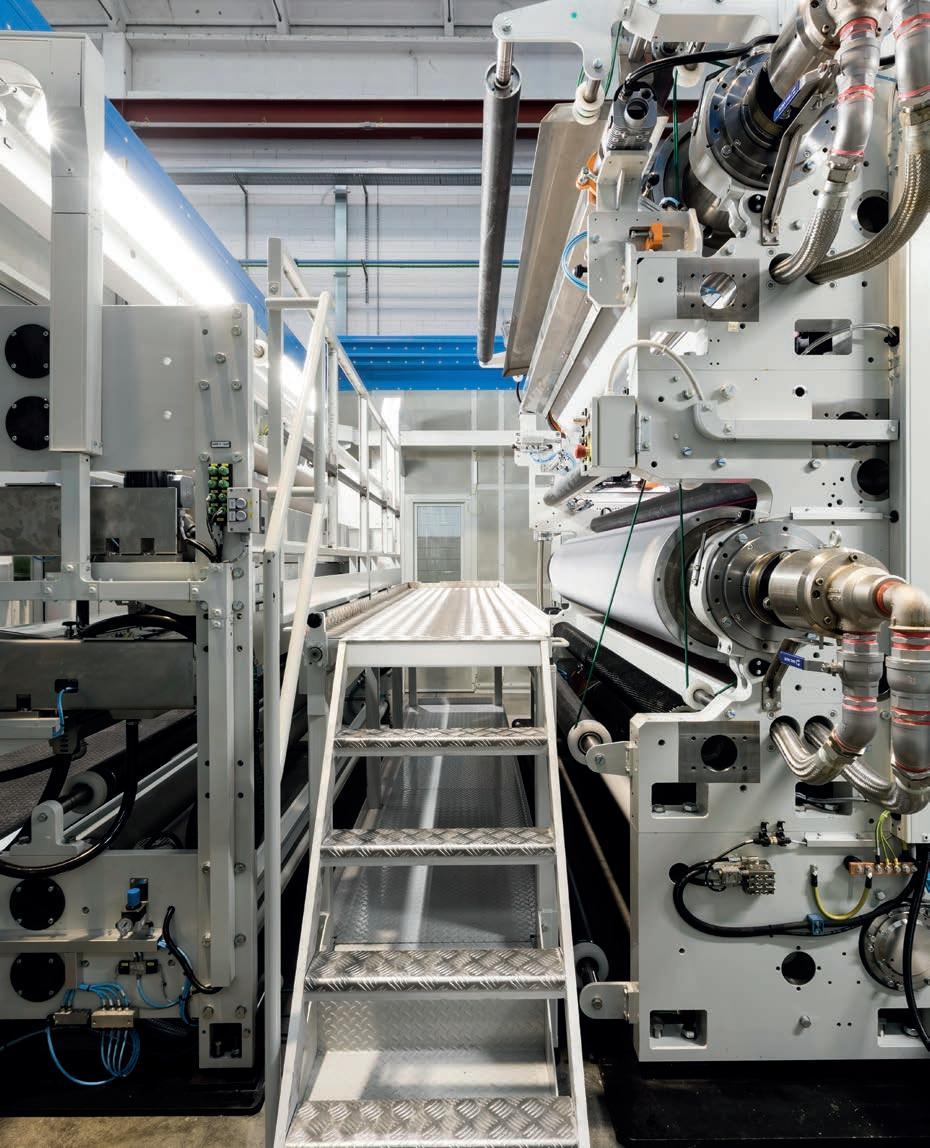
gambini.group
EDITORIAL HEADQUARTERS
Informa Markets – UK
240 Blackfriars Road, London, SE1 8BF, UK
Tel: +44 (0)20 7017 5000
Group Director
Chris Edwards: chris.edwards@informa.com
Senior Editor
Helen Morris: helen.morris@informa.com
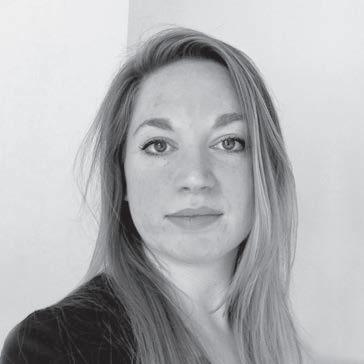
Event Director & Publisher
Tom Hill: tom.hill@informa.com
Executive Director
Chris Kilbee: chris.kilbee@informa.com
CEO Margaret Ma Connolly: margaret.connolly@informa.com
ADVERTISING ENQUIRIES
Europe & North America
Silvio Arati
T: 02 sarati@studioarati.it
South and Central America
Selma golini
T: ( ) 0 0 selma@gova.com.br
China, Hong Kong & Macau
Jennie Zhan
T: 20 0 info-china@informa.com
TISSUE WORLD MAGAZINE
is published bi-monthly. The subscription price is US$400 per year for 6 issues. Subscription is free for qualifed subscribers in the tissue industry.
Please send address corrections to:
Informa Markets – UK

240 Blackfriars Road, London, SE1 8BF, UK Tel: +44 (0)20 7017 5000 info@tissueworld.com
Subscription online at www.tissueworldmagazine.com
In Tissue World all measures are metric and all dollars ($) are US dollars, unless otherwise stated. Copyright 2022 by Informa Markets – UK. All rights reserved. All materials printed in Tissue World Magazine is owned by Informa Markets – UK and protected under the copyright act. No material may be reproduced in part or in whole without the prior written consent of Informa Markets – UK.
SPAIN: A TISSUE LABORATORY FOR ANSWERS TO A FLUCTUATING MARKET IN UNPRECEDENTED TIMES
Helen Morris
Senior Editor, Tissue World Magazine
In the major re-balancing of the Spanish tissue market some of the statistics in TWM’s Country Report are remarkable. First up: Spain is now the leading producer of private label tissue in Western Europe, overtaking long-time leader Germany. Overall, private label grew 13% in value sales in 2022 to reach nearly 78% in market share.
In the post-pandemic re-emergence going on, to be weighed on the plus side are more relaxed social restrictions, the major return of tourism – expected to be up 70% – and improved economic activities and consumer foodservice – the latter up 15%.
As a typical mature market, though, looking to the traditionally reliable source of population growth, the news is less encouraging. That fgure is expected to rise by just 0. in 2022: a current birth rate of . per 00,000 ofset by a 0.22 per 00,000 death rate. And on the economy, infation remains a major problem. As low as 0. prior to the pandemic, it is now 13% having dropped from a high of 26%.
Tissue imports and exports are balanced, and capacity additions continue to be measured to replace older and higher-cost tissue machines without oversupplying the market. Spain depends on market pulp imports, but has maintained a good cost position relative to its peers. Also, its carbon emissions are lower compared to the rest of the competitive set, except for France.
Priorities are being balanced in search of proft margin recovery. Companies are targeting key issues such as weighing quality and value, performance advancing innovation, and sustainability … increasingly important for customers. Four Operation Reports are positive.
To quote two: Luciano Lopez, Plant Director at Lucart Tissue & Soap, reports a full recovery of AfH in the south of Europe, with pre-pandemic consumption levels reached for tissue products generally. LC Paper General Manager Pau Vila expects AfH revenue to double in the next three years, and AH to show signifcant growth. He uses the verb ambitioning to underline the journey from the Nineties to today when the company works on 100% renewable energy.
Quote of the edition: This crisis will pass eventually, but it is unclear when or how the tissue business across Europe will adapt. Bruce anda, Senior Consultant, Fisher International.
Looking forward to seeing you in Düsseldorf
A lot of tissue has rolled of production lines since the last European Tissue World event took place in 2019. The return of the world’s largest tissue exhibition will introduce the industry to D sseldorf, Tissue World’s frst time in Germany. Some of foorplan capacity is confrmed, as are 20 exhibitors and 0 conference speakers.
Martin Krengel, Chief Executive, WEPA Group, will kick start the conference sessions and give the keynote address: Navigating a European family business in the V CA world – 202 as an important year for resilience and sustainable success. The Tissue World Düsseldorf conference runs alongside the exhibition with an overall theme: The Roadmap, The Riskmap: Plotting a course for Tissue in uncertain times. TWM will also mark this historic event with a special -page printed edition – which for the frst time will include a 2 -page Show Guide – featuring Country and Operation Reports on Germany, and distributed during our event.
AI ‘knows’ a good thing when it sees one
Artifcial Intelligence is a good ft for packaging, and in our Technical Theme, K rber Tissue’s Product Manager – Packaging & Digital Nicolò Squarzoni explains why. The company’s AI packer Sam Pack is busy making choices very much like a human would, only quicker, and cheaper. Defects such as print misalignments and side sealing are rejected. It is a convolutional neural network at work. In simple summary, it mimics the human brain by assessing information before choosing the relevant details and discarding the irrelevant. The network extracts the right details from the image allowing Sam to pack efciently, a process called classifcation. Squarzoni explains how the technology improves on both human inspection and algorithmic vision systems.
FrontIssues FI 3 Tissue World Magazine | January/February 2023
THE GROWING ROLE OF BIODIVERSITY AND CARBON STORAGE: WHAT TO EXPECT FOR THE TISSUE SECTOR



MOST ESTABLISHED TISSUE PAPER PRODUCTS ARE FIBRE-BASED, AND WOOD FIBRE-BASED PULP DOMINATES IN THE CONSUMER TISSUE SEGMENT WHILE RECOVERED FIBRE IS PRIMARILY USED IN THE AFH SEGMENT. ALTHOUGH THERE ARE SEVERAL INITIATIVES AND INVESTMENTS IN “NEW” OR “LESS TRADITIONAL” SOURCES E.G. STRAW, BAGASSE OR PREVIOUSLY UNUTILISED RECOVERED PAPER SOURCES, THE TISSUE VALUE CHAIN LOOKS TO REMAIN HIGHLY DEPENDENT ON WOOD FIBRE FOR A LONG TIME TO COME.
Tissue paper is a product used in the daily life by billions of people around the globe for numerous hygienic and health purposes, and a paper grade that has more or less been in constant growth throughout the last few decades. Volume wise, few if any other paper grades have shown such resilience towards economic turbulence, and where
growing and ageing populations combined with improved living standards have proved to be key drivers.
Most established tissue paper products are fbre-based, and wood fbre-based pulp dominates in the consumer tissue segment while recovered fbre is primarily used in the AfH segment. Although there are several initiatives and investments
MarketIssues MI MarketIssues MI
41% 17% 42%
BHKP BSKP Others (incl. other pulp grades, RCP and non-wood pulp)
Fig 1: Est. Global tissue fbre furnish 2022
Hampus Mörner Manager, AFRY Management Consulting
Tissue World Magazine | January/February 2023 4
Carolina Berg-Rustas Analyst, AFRY Management Consulting
e a a he ood re oo e e or rod h a e a ar e o read e or a a a d ore r are rre a a e h he a a e e o a r er a a er aro a er a a a d a a a e or r a d e or T he o e a a o ood re ro e a d ha he e e or a do ore o
Sami Pastila Senior Principal, AFRY Management Consulting
in “new” or “less traditional” sources e.g. straw, bagasse or previously unutilised recovered paper sources, the tissue value chain looks to remain highly dependent on wood fbre for a long time to come.
Figure 1 indicates global furnish mix in tissue products globally. The trend is towards more hardwood (BHKP), although softwood (BSKP), providing robustness and strength to the products, will remain important. European fbre baskets play an important role in fulflling the wood fbre demand for both pulp grades, although primarily for softwood where most of the fbre has its origin in the Nordics.
Wood fbre is a renewable and carbon neutral material which is a cornerstone in the work of phasing out fossil fuels and materials. There are many great examples where wealthy and democratic economies go hand-in-hand with growing prosperous forests. Still, rarely has sustainability been such a hot topic for wood fbre value chains as today, where perhaps biodiversity and carbon storage are the most current issues. In a way, this is understandable as several motivated businesses are discovering the advantages that wood fbre brings when taking action for a green transition.
Despite many of the sustainable aspects with wood fbre, there are examples of “near misses” and actual “causalities” of being promoted as a part of the strategy to phase out fossils.
Although not necessarily justifed, negative aspects with wood fbre are being intensely promoted. Business-as-usual when referring to utilising wood fbre looks to become a less likely event for a product like tissue, with a short life span and recycling challenges. Promoting the importance and advantages with wood fbre is becoming more important than ever.
One of the, so far biggest, policy readjustments for sustainability and forestry is currently taking place within the E where the outcome can afect each step of the wood fbre value chain and the supply of raw materials. Below we examine a selection of recent policies and processes where central topics are biodiversity, carbon storage and potential impact on wood fbre supply in Europe.
rre e o e
Numerous policies and initiatives connected to the forest sector and its resources are under revision within the EU; the Biodiversity Strategy, Forest Strategy, LULUCF, REDII/III, the Taxonomy Regulation, Sustainable Carbon Cycles, Carbon Border Adjustment and the Deforestation Regulation among others. Each policy has its own timeline and the potential impact on the wood fbre supply chain can difer.
Biodiversity: Policies aimed at
maintaining and strengthening biodiversity in the forest ecosystem are the Biodiversity and the Forest Strategy, the latter built upon the former. The main objective of the Biodiversity Strategy is to protect 30% of the land and 30% of the sea area within the EU. Of these 30% each, at least 10% should be strictly protected as illustrated in Figure 2. Legally binding nature restoration targets has also been introduced through this strategy.
According to the European Environmental Agency (EEA), 26% of the land area is currently protected within the EU. However, the share varies greatly among member states, largely due to variations in defnitions of protection. Also, the share of strictly protected areas is not yet quantifed. This implies that some countries would have to increase their protected areas, for instance the Nordic countries which according to the EEA currently protect almost 15% (Sweden and Finland).
Some EU countries like Germany might not fulfl the strict protection target, even though the overall protection target is fulflled and therefore needs to increase the strict protection share. In either of the cases, this will likely restrict harvesting and harvesting potential if implemented.
As the Forest Strategy is built upon the Biodiversity Strategy, the main objective
is to enhance biodiversity as well as contribute to greenhouse gas emission reduction targets. It promotes the use of wood fbre for long-lived products, rather than short-lived ones such as tissue, but also usage of continuous cover forestry and re-forestation. Wood fbre supply chains in many European countries are largely built on forestry without constant cover.
In addition to these policies, the new EU Deforestation Regulation, which is also aimed at safeguarding biodiversity, will increase the need for traceability of fbre through the value chain. In practice, the location of where the wood fbre was harvested needs to be reported for products entering or leaving the EU market.
Carbon storage: Policies aimed at carbon storage might also restrict the wood fbre supply in Europe through decreased harvesting levels. The main policies connected to this topic are the LULUCF and the Sustainable Carbon Cycles policy. The LULUCF Regulation is aimed at incentivising member states to decrease emissions and increase removals of greenhouse gases from managed lands (agriculture, forestry, etc).
A revision of the current LULUCF Regulation was agreed upon at the end of 2022, which will further enhance the role of forests in carbon removals. From 2026
MarketIssues MI
Soft protection 20% Strict protection 10%
Fig 2: rote te share of lan area E io i ersit trate
Tissue World Magazine | January/February 2023 5
ACCORDING TO THE EUROPEAN ENVIRONMENTAL AGENCY (EEA), 26% OF THE LAND AREA IS CURRENTLY PROTECTED WITHIN THE EU. HOWEVER, THE SHARE VARIES GREATLY AMONG MEMBER STATES, LARGELY DUE TO VARIATIONS IN DEFINITIONS OF PROTECTION. ALSO, THE SHARE OF STRICTLY PROTECTED AREAS IS NOT YET QUANTIFIED. THIS IMPLIES THAT SOME COUNTRIES WOULD HAVE TO INCREASE THEIR PROTECTED AREAS.
SHORT LIFE SPAN OF TISSUE PRODUCTS VS THE WOOD FIBRE BRINGS CHALLENGES AS NEW POLICY FRAMEWORKS ARE PRODUCED. ALTHOUGH ACTIVE AND WEALTHY FORESTRY CAN BE AN ENABLER FOR IMPROVED GROWTH AND CARBON STORAGE, IT IS HARD TO SEE THAT OTHER “LESS TRADITIONAL” FIBRE SOURCES WILL NOT BE AN INCREASINGLY IMPORTANT PART OF THE TISSUE FURNISH EQUATION AHEAD.
onwards, carbon removal generated by forests and other managed land has to be larger than the emissions from these lands. Each member state will also have removal targets to be delivered by 2030. As forests are the main sink of the L L CF-sector and the forest sink is initially reduced through tree harvesting, some member states have the pressure to decrease harvesting levels if there are no other ways to reach the removal targets set by the EU.
In addition, the Sustainable Carbon Cycles policy is aimed at promoting carbon removal activities in businesses primarily through the creation of a voluntary carbon market. In such a market, forest owners could theoretically sell carbon credits from standing forests, instead of wood fbre from harvested forests. Such a market would be a direct competitor to sourcing of wood fbre resources.
In all, the above stated policies can afect the wood fbre supply and production of tissue in Europe through:
• Increased forest protection (less land available for forestry)
• Changed forest management practices unsuitable for current practices (continuous cover forestry instead of fnal felling)
Promotion of long-lived products instead of short-lived ones
• Increased need for supply chain traceability
• Decreased national harvesting levels (to maintain carbon removals on managed lands)
• Competing demand of the forest resource (from emerging carbon credit markets)
• Production leakage through shifted production from Europe to other parts of the world
• Accelerating trend for more hardwood in tissue furnish (primarily eucalyptus).
The road ahead
Even though there are numerous policies on the table, it is not certain if or to what extent the wood fbre availability will be afected as many of the processes are in the making. Still, there are clouds on the
horizon for the industry where awareness, precautions, and measures become key. Potential actions and areas to address are elaborated below.
Sourcing: As known and stated above, the relatively short life span of tissue products vs the wood fbre brings challenges as new policy frameworks are produced. Although active and wealthy forestry can be an enabler for improved growth and carbon storage, it is hard to see that other “less traditional fbre sources will not be an increasingly important part of the tissue furnish equation ahead.
Optimised sourcing and less waste are actual and ongoing steps, but so are initiatives and experimenting in new sources, both virgin fbre based and recycled. There are potentials and examples in collecting and recycling certain tissue grades as well as exploring new RCP sources e.g. cartonboards. Areas where the tissue sector potentially can do more with the right partnership and dedication.
Join forces: With the sizeable revision and work taking place the need for knowledge is of great importance. Industrial sectors dependent on virgin wood fbre have experience of cooperation on political and informative tasks, although to a large extent mainly within its respective sector, value chain and associations. The time to join forces, cross functional cooperation and focus on the common touch and pain points
is more important than ever.
For instance, one of the greatest challenges in the sustainability framework is the development and refnement of indicators, metrics, and methodologies to measure progress towards targets set by companies. Knowledge is key in such a development work. However, knowledge not shared, informed, and communicated correctly to political decision makers in processes like the ones mentioned above is of little use, unfortunately.
Openness: There are learnings and areas of improvements in current forestry methods, and lessons are constantly learnt as biodiversity and carbon storage are taken more seriously than ever in Europe. As an example, forestry based on fnal felling and forestry based on continuous cover forestry are often opposed to each other as there is only one option.
Simplifed, while fnal felling provides wood fbre from a limited land area, but with a visible footprint, continuous cover forestry demands more land to produce the same amount of wood fbre but with a less visibly footprint.
Each of the two systems, and practices between these two, can be suitable depending on local conditions and new solutions, technology and enablers (e.g. drones and improved data utilisation) are entering the market. Although traditional methods might as well be the correct way in many cases, openness, and a willingness to reconsider, fne tune, and challenge, is the key.
Promote: Biodiversity and carbon storage are complex topics and together they form the new frontier in future forest sustainability management. As with many frontier investments, experiments are needed to fnd new solutions. With uncertainty, new opportunities come. Businesses who are willing to act now rather than later will stand a great chance to shape the path.
THERE ARE LEARNINGS AND AREAS OF IMPROVEMENTS IN CURRENT FORESTRY METHODS, AND LESSONS ARE CONSTANTLY LEARNT AS BIODIVERSITY AND CARBON STORAGE ARE TAKEN MORE SERIOUSLY THAN EVER IN EUROPE. AS AN EXAMPLE, FORESTRY BASED ON FINAL FELLING AND FORESTRY BASED ON CONTINUOUS COVER FORESTRY ARE OFTEN OPPOSED TO EACH OTHER AS THERE IS ONLY ONE OPTION. SIMPLIFIED, WHILE FINAL FELLING PROVIDES WOOD FIBRE FROM A LIMITED LAND AREA, BUT WITH A VISIBLE FOOTPRINT, CONTINUOUS COVER FORESTRY DEMANDS MORE LAND TO PRODUCE SAME AMOUNT OF WOOD FIBRE BUT WITH A LESS VISIBLY FOOTPRINT.
MarketIssues MI
AS KNOWN AND STATED, THE RELATIVELY
Tissue World Magazine | January/February 2023 6
GLOBAL NEWS UPDATE
GLOBAL
The big reunion – countdown to Tissue World Düsseldorf is on!
The very frst European Tissue World event since 20 – and the world’s largest tissue exhibition, for the frst time held in Germany – is gearing up to open its doors as of foorplan capacity confrmed flled.
Thousands of tissue industry professionals including 20 exhibitors and 0 conference speakers will attend Tissue World D sseldorf between 2 - 0 March to reunite and discover ground-breaking new machinery. The event ofers an unrivalled platform to meet and greet hundreds of market leaders showcasing the latest innovations and technical solutions.
Conference
With a theme of The Roadmap, The Riskmap: Plotting a course for Tissue in uncertain times, the Tissue World D sseldorf conference runs alongside the exhibition. It will examine key business drivers for efective strategy and fnancial stability, as well as looking into the industry’s sustainable options to be prepared for an uncertain future. Some 0 speakers and over 0 talks are already confrmed, as well as carefully curated technical sessions focusing on fresh innovation from tissue making through to converting.
Martin Krengel, Chief Executive WEPA Group, will kickstart the conference sessions and give the keynote address: Navigating a European family business in the V CA world – 202 as an important year for resilience and sustainable success.
Confrmed speakers also include: Tobias L ning, Senior Vice President
Central Europe, Mets Tissue
Khalid Saifullah, Managing Director, Star Tissue
Antonia Colib anu, Chief Operating Ofcer, Geopolitical Futures
Donato Giorgio, President Global Supply Chain, Essity Hampus M rner, Senior Consultant Bioindustry, AFR Management Consulting
Marc Miribel, President, MP Hygiene rban Lundberg, Senior Consultant, Fisher International.
Tissue World Magazine and Tissue World Düsseldorf Show Guide
For the frst time, the 2 -page Tissue World D sseldorf Show Guide will be printed as part of Tissue World Magazine’s March April issue. Included in the centre pages of the industry’s leading independent trade magazine, the issue and Show Guide 202 will be a collector’s magazine for readers, advertisers, exhibitors and visitors.
Networking: Happy Hour reunion
Exhibition organisers Informa Markets will be hosting two Happy Hour networking events, including a ‘Welcome to D sseldorf ’ event held at a traditional brewery on the evening of Monday 2 March.
Come and say hello and join us for some networking drinks and a chance to meet with attendees ahead of the show. All Tissue World visitors, conference delegates, speakers and exhibitors are welcome.
We look forward to seeing you there
BRAZIL
Bracell expands tissue presence to acquire OL Papéis
Brazilian pulp company Bracell has further boosted its tissue manufacturing presence after announcing it will acquire OL Pap is and its toilet paper, paper towels and Fofura Baby diaper brand. OL Pap is’ assets are located in Feira de Santana and S o Gon alo dos Campos in Bahia, and Pombos in Pernambuco in the Northeast region of Brazil.
S rgio Montanha, Bracell’s Head of Tissue Operations, said: This acquisition reinforces Bracell’s strategy to expand its business and to continue investing in Brazil. OL Pap is has a signifcant market share in the Northeast, a region that represents of the volume of toilet paper sold in Brazil in 202 . Its assets, in both manufacturing and brands, will complement Bracell’s operations in Brazil.
In September 202 , Bracell also started operating a new generation pulp mill in Len óis Paulista, S o Paulo, expanding its production capacity from 2 0,000tpy to .0m tpy of kraft pulp, or , m tpy of dissolving pulp. Following growth of the markets in Latin America, Bracell responded by investing in a tissue factory at its S o Paulo plant, which it announced in early 2022. The tissue mill will be located next to its pulp mill in Len óis Paulista, Sao Paulo, and once up and running in 202 will have four tissue machines producing toilet paper and paper towels, with a production capacity of 2 0,000tpy.
OL Pap is was founded in 200 and is ranked second in market share for toilet paper in Brazil’s Northeast region. Its operations include fve brands of toilet paper, fve brands of kitchen paper towels and napkins and one brand of diapers. Bracell produces dissolving pulp and specialty cellulose with two main mill operations in Brazil in Bahia and S o Paulo.
In addition to its operations in Brazil, Bracell has a management ofce in Singapore and sales ofces in Asia, Europe and the .S. The acquisition is under the review of the Administrative Council for Economic Defense and is expected to complete within 0 to 0 days. Bracell is a member of the Singaporebased RGE, a group of resource-based manufacturing companies.
News in Brief NB Tissue World Magazine | January/February 2023 7
News in Brief NB
A roundup of news from across the global tissue industry. To get the very latest news go to
www.tissueworldmagazine.com
IT WILL EXAMINE KEY BUSINESS DRIVERS FOR EFFECTIVE STRATEGY AND FINANCIAL STABILITY, AS WELL AS LOOKING INTO THE INDUSTRY’S SUSTAINABLE OPTIONS TO BE PREPARED FOR AN UNCERTAIN FUTURE. SOME 30+ SPEAKERS AND OVER 30 TALKS ARE ALREADY CONFIRMED, AS WELL AS CAREFULLY CURATED TECHNICAL SESSIONS FOCUSING ON FRESH INNOVATION FROM TISSUE MAKING THROUGH TO CONVERTING.






UK
Northwood Group completes acquisition of Consuma Paper Product’s trade and assets
The K’s Northwood Group has completed the acquisition of Consuma Paper Product’s trade and assets and rebranded as Northwood Consuma Tissue.
As of December, the business is now under 00 ownership by the Northwood shareholders and operating as Northwood Consuma Tissue.
Chairman Paul Fecher said: We welcome to the Northwood family our new colleagues in Grantham many of whom are very familiar with Northwood through years of working closely together especially in the supply of high-quality facial tissue as required by the company.
The transaction will allow for the planned integration of the Birmingham and Grantham consumer focussed businesses to operate as part of the Northwood
Accrol Group announces plans for 70,000tpy tissue plant
K-based independent tissue converter t Group has announced plans to build a tissue production plant, which is expected to provide c. 0 of the group’s annual tissue requirement. In its latest strategic review, the company outlined plans for the tissue plant to be operational by mid-202 at an optimal location , while 0 of its energy costs are expected to be delivered through PV solar. It said it planned to continue its focus on its core toilet and kitchen towel business, its facial and wet wipe business, and develop a licensed business model and grow directto-consumer Oceans brand. Plans to acquire selectively to strengthen and extend our product ofering were also announced.
Dan Wright, Executive Chairman of Accrol, said: Over the last four years, Accrol has been transformed as an organisation to one that currently supplies c.2 . of the K market’s tissue volumes and has considerable further capacity. Our state-of-the-art businesses are in an incredibly strong position to beneft in a private label market, which is growing rapidly and signifcantly. Our customer base is strong and varied and the ability to passon cost increases swiftly has been evidenced in the group’s half year results.

In the strategic review, the company said it anticipated benefts of the tissue mill will include reduced volatility in tissue input costs for the K tissue conversion business, enhanced security and visibility of tissue supply, which will reduce working capital requirements in the K tissue conversion business.
It added: Even prior to the war in kraine, the K has seen a long-term trend of energy cost infation, rising from an average of p per KW Hr in 20 to p in 202 and, subsequent to the war, in excess of 0p. We anticipate that the mill will operate, crucially for the duration of its life, with an energy cost that is lower than levels seen in the K prior to the war in the kraine.
THE TRANSACTION WILL ALLOW FOR THE PLANNED INTEGRATION OF THE BIRMINGHAM AND GRANTHAM CONSUMER FOCUSSED BUSINESSES TO OPERATE AS PART OF THE NORTHWOOD COMPANIES IN THE UK AND SPAIN, BRINGING TOGETHER THE SITES OFFERING OF ROLLED AND FOLDED RETAIL TISSUE PRODUCTS. NORTHWOOD IS A LEADING SUPPLIER OF PARENT REELS INTO THE PAPER HYGIENE SECTOR, WHILE NORTHWOOD CONSUMA TISSUE IS A MANUFACTURER OF CUSTOMER’S OWN BRAND OF FACIAL TISSUES, POCKET PACKS, HOUSEHOLD TOWELS AND TOILET PAPER.
Companies in the K and Spain, bringing together the sites ofering of rolled and folded retail tissue products.
He added: Both sites have state of the art equipment and dedicated professional staf focussing on servicing the requirements of the consumer sector.
This acquisition completes the range of tissue products that Northwood is now able
to ofer in facial tissue, kitchen towel and toilet tissue.
Northwood is a leading supplier of parent reels into the paper hygiene sector, while Northwood Consuma Tissue is a manufacturer of customer’s own brand of facial tissues, pocket packs, household towels and toilet paper for many of the K’s biggest grocery retailers.
News in Brief NB Tissue World Magazine | January/February 2023 9
“Over the last four years, Accrol has been transformed,” Dan Wright, Executive Chairman, Accrol Group
Paper machine is largest single investment in WEPA Group history
The WEPA Group has started-up its second Valmet-supplied paper machine at its Welsh site in Bridgend, doubling its production capacity for the British market.
The tissue machine has a production capacity of 0,000tpy and is designed to produce hygiene paper products from virgin fbres as well as 00 recycled fbres.
It is then converted into toilet and kitchen paper for the K consumer market.
WEPA Group said the paper machine is designed to produce the highest
quality in terms of softness, strength and absorbency , and the investment project also includes new buildings to house the stock preparation equipment and the paper machine.
Several converting projects have also been executed including a new line for lotioned and perfumed bathroom tissue products.
Martin Krengel, Chief Executive of the WEPA Group, said: With the largest single investment in the history of the WEPA Group, we are further strengthening our claim to technology leadership and market
leadership for sustainable hygiene papers.
The K is a signifcant growth market for WEPA. To us it is important to foster market-orientation and to produce for our K customers in their own country.
The investment in Bridgend is an investment in the future and our long-term customer partnership.
It strengthens our position in the K market with highest benchmarks in sustainability and product quality, and as part of the project we created over 0 new jobs.
The workforce at the Welsh WEPA site now amounts to 2 people.
The site in Bridgend has been part of the WEPA Group since 20 – initially as a joint venture before being fully acquired in 20 . With a total of 22 paper machines across European sites, the group has a production capacity of approximately 0,000tpy.

News in Brief NB Tissue World Magazine | January/February 2023 10
“THE UK IS A SIGNIFICANT GROWTH MARKET FOR WEPA. TO US IT IS IMPORTANT TO FOSTER MARKET-ORIENTATION AND TO PRODUCE FOR OUR UK CUSTOMERS IN THEIR OWN COUNTRY. THE INVESTMENT IN BRIDGEND IS AN INVESTMENT IN THE FUTURE AND OUR LONG-TERM CUSTOMER PARTNERSHIP. IT STRENGTHENS OUR POSITION IN THE UK MARKET WITH HIGHEST BENCHMARKS IN SUSTAINABILITY AND PRODUCT QUALITY, AND AS PART OF THE PROJECT WE CREATED OVER 50 NEW JOBS.”
The largest single investment in WEPA Group history: The Valmet paper machine at the Bridgend site
INDIA
Gayatrishakti moves into tissue market with TM start-up
Paper and board manufacturer
Gayatrishakti has announced its move into the tissue market after investing in a Toscotec-supplied complete AHEAD . tissue machine to be installed at its plant in Vapi, Gujarat. The tissue line is expected to be up and running at Gayatrishakti Tissue’s site in 202 .
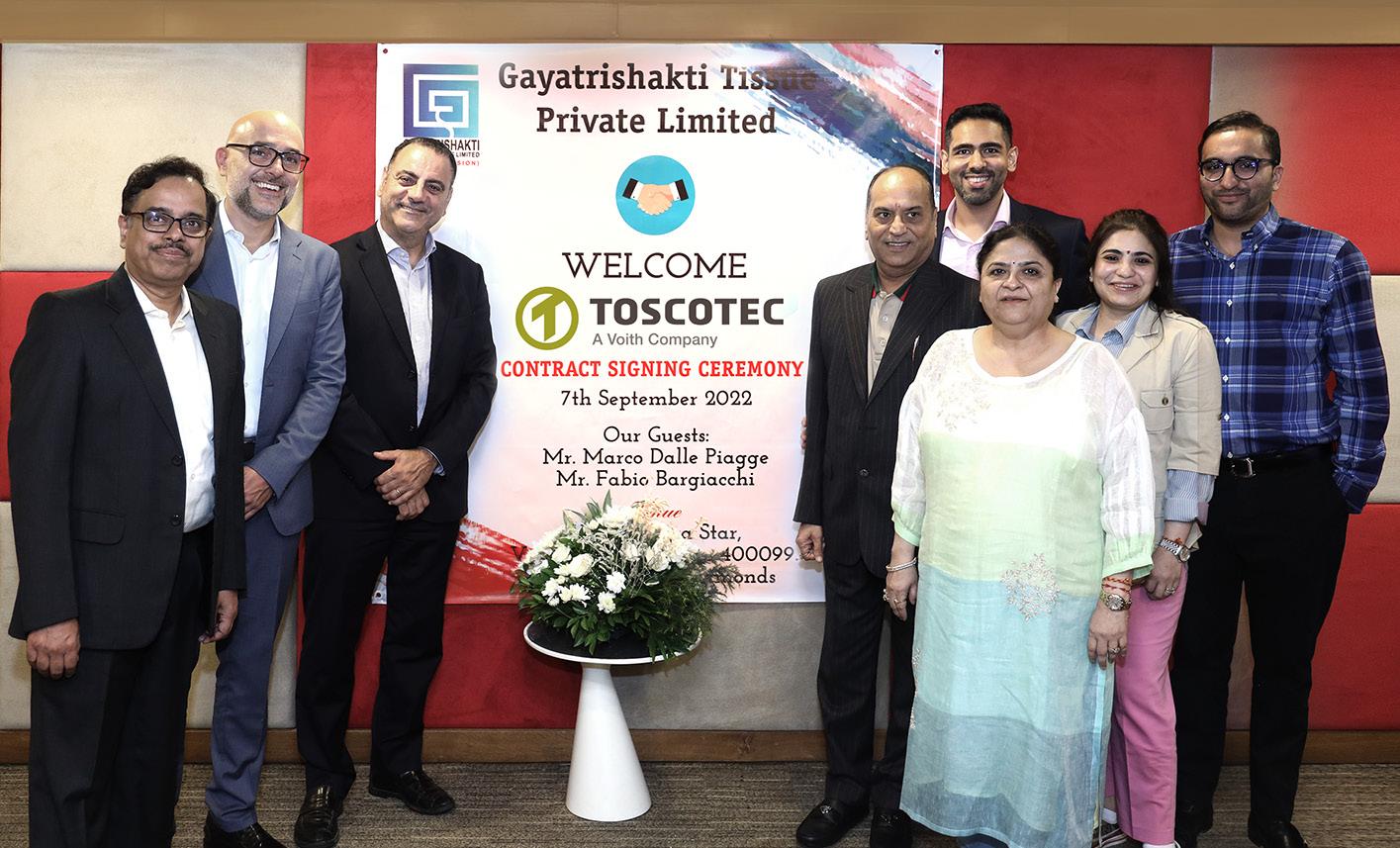
It has a sheet trim width of 2. m, an operating speed of , 00m min, and a production of over ,000tpy. The scope of supply includes Toscotec’s best-in-class drying confguration including an upgraded design shoe press TT NextPress, a thirdgeneration design TT S D Steel ankee Dryer and high-efciency TT Hood. The service package includes ESCONNECTVISION Augmented Reality remote assistance system and start-up support.
Shri G. N. Agarwal, Managing Director of Gayatrishakti Paper & Board, said:
Gayatrishakti is a well-established board manufacturer in India and based on our strong background in paper and board we wanted to invest in state-of-the-art tissue making technology as newcomers in tissue.
Gayatrishakti Tissue is a subsidiary of Gayatrishakti Paper & Board, a leading manufacturer of premium grades of duplex packaging boards and kraft paper.
APP announces plans for 1.2m tpy mill in India
Asia Pulp & Paper (APP) Sinar Mas has confrmed plans to build a .2m tpy printing paper, tissue, and packaging board production facility in the Raigad district of Maharashtra, India. The site in Dherand village is expected to come online in 202 , subject to positive outcome of a feasibility study and permitting process.
A feasibility study is currently being undertaken by APP to ensure the facility meets operational requirements.
It would then be ramped up to full production in 202 . APP said the project would be of strategic importance for its operations in Indonesia, and the plant would source its material from Indonesian operations. The company would also invest .2bn to develop the facility.
An APP representative said: The India Project is a strategic way forward for us to support our operations in Indonesia while marking our presence in the Indian market which ofers bright prospects with its strong growth.
CHINA
Asia Symbol announces move into tissue market with machinery start-ups
Asia Symbol has started tissue production after starting-up tissue machines, converting lines and packaging machinery supplied by BaoSuo Enterprise Group across factories in mainland China. The projects include a number of BC 00-2 0 Crescent Former ankee Tissue Machines produced by BaoSuo Enterprise Group subsidiary Baotuo Paper Machine.
Machines were also supplied by BaoSuo Enterprise Group subsidiaries BaoSuo Machinery and Bao in Technology and include: an H-PL 0-2 00 full automatic facial tissue production line, an HFG 0- 00 full automatic facial tissue production line, an D-PL 0- 000 non-stop rewinder line, D-PL 0C- 000 non-stop rewinder line, D-PL 0SE-2 00 non-stop RT rewinder line, PF-EA- 000 automatic slitting rewinder (two-colour printing), and an M -N P 22 - 00 full automatic N Fold towel production line.
News in Brief NB Tissue World Magazine | January/February 2023 11
ASIA PULP & PAPER (APP) SINAR MAS HAS CONFIRMED PLANS TO BUILD A 1.2M TPY PRINTING PAPER, TISSUE, AND PACKAGING BOARD PRODUCTION FACILITY IN THE RAIGAD DISTRICT OF MAHARASHTRA, INDIA.
Start-up team: India’s Gayatrishakti moves into the tissue market
TURKEY
Turkish tissue producer Essel K t has reached a milestone on its AHEAD 2.2L machine after it exceeded its guaranteed production by a large margin and surpassed bulk and softness parameters .
Ahmet Temuroglu, Production Coordinator and Burak Ipek, Maintenance Manager at Essel
K it, said: The target of our performance test was successfully accomplished with a production of 2 0, 00tpy on a 2 gsm towel grade at a speed of , 0m min.
Supplied by Toscotec on a turnkey basis, PM had come online at Essel’s Osmaniye mill in Turkey in October 202 .

AMERICA re or o d a re
Procter & Gamble (P&G) has reported solid results in its second quarter fscal year report, despite a very difcult cost and operating environment that led to declining revenue and proft.
For the three-month period ended December, net sales fell year-on-year to 20. bn.
The company said unfavourable foreign exchange had a impact on net sales,
while an organic sales increase was driven by a 0 increase from higher pricing and a increase from positive product mix.
In the company’s Baby, Feminine and Family Care segment – which includes toilet tissue, facial tissues and paper towels – net sales were down to ,0 bn, while organic sales increased versus a year ago.
Baby Care organic sales increased low single digits, a result the company said was due to increased pricing, partially ofset by volume declines from market contraction.
Feminine Care organic sales increased high single digits driven by increased pricing and positive geographic mix, partially ofset by volume declines in emerging markets.
Family Care organic sales increased low single digits due to increased pricing, partially ofset by lower volumes due to market contraction and market share softness.
on Moeller, Chairman of the Board, President and Chief Executive, said: We delivered solid results in the second quarter of fscal year 202 in what continues to be a very difcult cost and operating environment.
Progress against our plan fscal year to date enables us to raise our sales growth outlook for fscal 202 and maintain our guidance range for EPS growth despite signifcant headwinds.
We remain committed to our integrated
strategies of a focused product portfolio, superiority, productivity, constructive disruption and an agile and accountable organisation structure.
These strategies have enabled us to build and sustain strong momentum. They remain the right strategies to navigate through the near-term challenges we’re facing and continue to deliver balanced growth and value creation.
Marcal Paper boosts premium AfH presence with von Drehle acquisition
America’s Marcal Paper has increased its presence in the premium towel and tissue AfH market after acquiring von Drehle Corporation.
Following the purchase, Marcal Paper now operates production facilities in North Carolina, Mississippi, Tennessee, and Nevada, in addition to its locations in Pennsylvania, New ersey, and Vermont, expanding its footprint to service customers all along the East Coast and the country.
Von Drehle Corporation will now operate as a division of Marcal Paper.
Rob Baron, President and Chief Executive Ofcer of Marcal Paper, said: Today is an important day for Marcal Paper as we are excited to welcome the von Drehle associates to the Marcal family.
Over the past few years, our team has successfully weathered several storms, including the impact of the Covidpandemic, and come out stronger for it.
News in Brief NB Tissue World Magazine | January/February 2023 12
e a h e e a rod o e e o T
Getting AHEAD 2.2L: he Essel t tea hi h hel e sur ass uarantee ro u tion tar ets b a lar e ar in
This transaction is the next step on our growth journey, and von Drehle is the right team with whom to partner.
We share a commitment to being environmental leaders, community stewards, and trusted employers, and we take great pride in our shared histories as family-owned companies.
Baron told TWM that the growth of the AfH market in the nited States has been driven by pent-up demand for increased travel and leisure activity coming out of the Covid- pandemic .
He added: We are not seeing the dramatic shift towards premium products in the AfH market that is occurring in the At-Home space.
The AfH market is seeking to meet demand with reliable and afordable products, and we at Marcal Paper are prepared to successfully service these customers, as we have for nearly a century.
Today’s announcement marks the beginning of the next chapter, and an exciting growth step for our company.
COLOMBIA
GrandBay Papeles Nacionales boosts capacity with TM investment
GrandBay Papeles Nacionales has increased its production capacity after investing in a Toscotec-supplied AHEAD 2.2 turnkey tissue line.
PM will be based at the company’s Pereira production base and is scheduled for start-up in 202 .
It has a sheet trim width of . m, a design speed of 2,200m min and an annual production capacity of over 0,000 tons.
It features a TT NextPress latest shoe press generation, a thirdgeneration design TT S D Steel ankee Dryer with patented heads insulation system, and high efciency TT Hood.
Cesar Solano, Chief Executive of GrandBay Group, said: We are continuing to grow with the market, and satisfying the needs of consumers with products of the best quality while accompanying the growth of our clients are the guiding principles for our vision.
Papeles Nacionales operates a tissue mill in Pereira, Colombia, and is part of the GrandBay Group, a Latin American company established in and dedicated to the manufacturing, converting and sales of personal care and home products of premium quality, with presence in more than 2 countries in Central America, the Andean and Caribbean region.
It is Toscotec’s second project with GrandBay which is also currently installing a complete AHEAD 2.2L tissue line at GrandBay Papelera Internacional in Guatemala.
POLAND
Velvet Care to acquire 100% stake in Almus
Tissue manufacturer Velvet Care has signed a preliminary agreement to purchase 00 of shares in family-owned Polish tissue converting company Almus. Almus manufactures toilet paper, paper towel and professional products at its plant in S omniki, Ma opolska Province, where it houses fve processing lines with a capacity of 0,000tpy. It also supplies products sold under private labels by commercial brands in Poland and abroad and is a manufacturer of paper products under the Almusso brand.
Artur Pielak, president of Velvet Care, said: Since the moment it was established, Velvet Care has been consistently aiming for business development. The acquisition of Almus is a strategic
decision that reinforces our position as a leader in the paper industry in the Central Europe region.
After the historic moment in 2022 – namely when the threshold of PLN bn turnover was exceeded and after incorporating Almus into the structure of the Velvet CARE Group – the management board is ready to designate new ambitious goals. Another milestone that we plan to accomplish by 202 is the turnover on the level of PLN2bn.
Wojciech Starnawski, President of ALM S added: This is also an opportunity for procuring new clients in the country and abroad and establishing cooperation within the scope of production, including delivery of the top-quality tissue manufactured at Velvet Care’s Klucze plant.
After fnalisation and merger of the companies, the Velvet Care Group – which currently consists of Velvet Care and the Czech company Moracell – will increase its processing capacity by almost 0 to 2 0,000tpy.
It will then have 2 processing lines, three paper machines and fve warehouses located in three production plants in Klucze, S omniki and ab ice (Czech Republic).
The share purchase transaction is currently being approved by the Polish Ofce of Competition and Consumer Protection, and a fnal decision is expected to be made in this quarter.
The purchase is a development strategy of Velvet Care set out by the management board and its majority shareholder, Abris Capital Partners.
It aims to maintain a strong leader position in the paper industry in Central Europe. In the future, the company said it is planning to further develop its business in the markets in its region and continue to work on next strategic acquisitions.
Court of Florence
As ordered by the Judge, hereinafter it is published a portion of the precautionary order issued by the Court of Florence on November 28th, 2022:
“Orders Kairos Srl, in person of the legal representative pro tempore, Messrs. Daniele Bernacchi and Maurizio Giannoni, for themselves, and any other person acting in the name and on behalf of Kairos Srl, to refrain from distribution, disclosure and use (including the production, advertising and marketing of products intended for sale) of MTC’s technical drawings, including those bearing Dora Design scroll”.
News in Brief NB Tissue World Magazine | January/February 2023 13
IMPACT OF OUT-OF-OFFICE WORK OPPORTUNITIES AND SPAIN'S PREFERRED CLIMATE EXPECTED TO RESULT IN FURTHER GAINS
However, long-range population predictions continue to call for a contraction, as Spain's population growth in 2022 is estimated to be 0.13%.
The Spanish tissue manufacturing business was last reviewed in this column a little over two years ago. We noted that Spain had signifcantly recovered from the 2009 recession by 2019. However, when the population peaked in 2012, the United Nations population division forecasted continued shrinkage due to the low birth rate. Since then, the global Covid-19 pandemic has upset the global economy and supply chains, followed by President Putin’s invasion of Ukraine.


Population growth and the economy are fundamental drivers of tissue consumption in a very mature market – hence the negative impact it has received due to recent events.
Spain's population growth in 2022 is estimated to be 0.13% by the World Factbook. The current birth rate of 7.13 births per 00,000 population is ofset by a death rate of 10.22 deaths per 100,000. However, the population growth comes
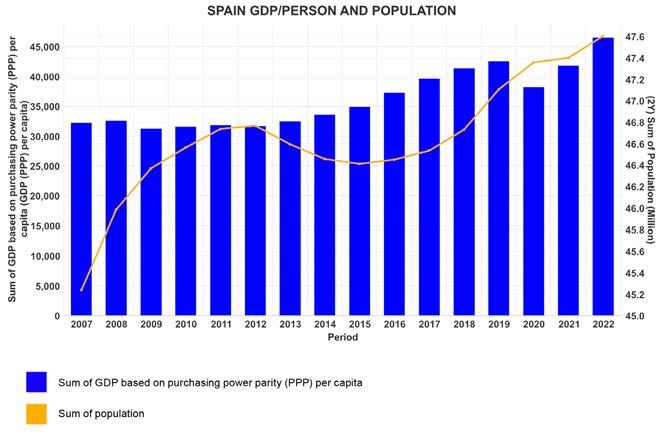
from a net positive migration rate of 4.35 immigrants per 100,000. This trend in population is shown in Figure 1.
The country’s population hit a low point in 2015-2016, before resuming growth in 2017. It’s interesting to note that immigration to Spain's sunny climate appears to have expanded with the pandemic and increased remote working. However, long-range population predictions continue to call for a contraction.
Figure also shows the efect of the pandemic on the country’s economy as a dip in GDP per person occurred in 2020-2021, with growth resuming in 2022. Overall GDP growth was 1.95% in 2019. Together, the factors shown in Figure 1 should result in increased total tissue demand.
Tissue demand is also driven by consumers' expectations of their economic security. Figure 2 shows the trends of infation and unemployment on consumer sentiment. Infation was as low as 0.
Janda
until the global pandemic disrupted supply chains and war upset energy supplies. Unemployment has continued to improve since 2013, dropping from 26% to 13%. Considering the global environment, these numbers do not look like unusual drags on tissue consumption.
Tissue imports and exports are in rough balance, as shown in Figures 3 and 4. Tissue
POPULATION GROWTH AND THE ECONOMY ARE DRIVERS OF TISSUE CONSUMPTION IN A VERY MATURE MARKET – HENCE THE NEGATIVE IMPACT IT HAS RECEIVED DUE TO RECENT EVENTS. SPAIN'S POPULATION GROWTH IN 2022 IS ESTIMATED TO BE 0.13% BY THE WORLD FACTBOOK. THE CURRENT BIRTH RATE OF 7.13 BIRTHS PER 100,000 POPULATION IS OFFSET BY A DEATH RATE OF 10.22 DEATHS PER 100,000.
Country Report: Spain CR Country Report: Spain CR
Bruce
Senior Consultant, Fisher International
14 Tissue World Magazine | January/February 2023 Figure 1:
and
Spain's GDP/Person
Population
trade represents less than 20% of Spain's tissue capacity. Tissue imports are sourced from France, Germany, Italy, and Portugal, as these are Spain's immediate neighbours and each of these countries possesses advanced process tissue capacity capable of high absorbent capacity towels, unlike Spain.







The same tissue import sources are also export customers. Belgium, Poland, and the United Kingdom are also tissue customers, as shown in Figure 4. The long-term balance in tissue trade indicates that Spanish tissue producers are focused on the domestic tissue demand rate for managing capacity.
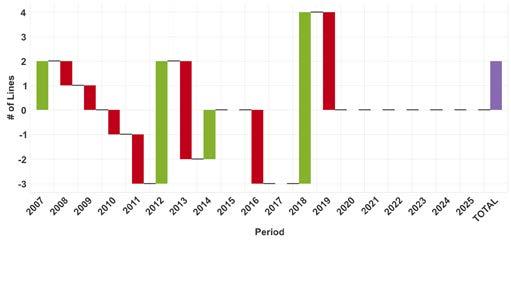
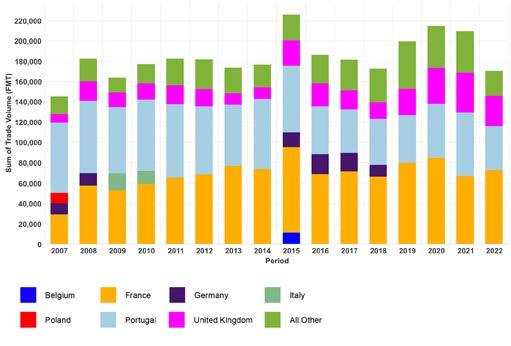

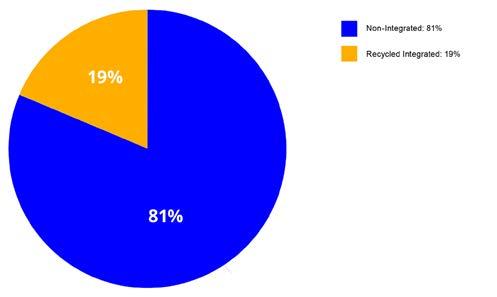

Country Report: Spain CR Tissue World Magazine | January/February 2023 15
Figure 7: Spain Tissue Fibre Sources
Figure 6: Spain Tissue Mill Site Type
Figure 2: ain s n ation an ne lo ent
Figure 3: ain issue orts ren
Figure 4: Spain Tissue Exports Trend
Figure 5: Spain Tissue Machine Count Changes
HALF OF SPAIN'S TISSUE FIBRE SOURCE IS MARKET EUCALYPTUS PULP, AS SEEN IN FIGURE 7. THIS IS BALANCED BY SOUTHERN SOFTWOOD WITH SMALLER AMOUNTS OF NORTHERN SOFTWOOD AND HARDWOOD.
The focus on domestic demand results in a cautious approach to adding new capacity, as shown in Figure 5. This trend plots the number of tissue machines added or removed from Spain’s feet. New machines in 2007, 2012, 2014, and 2018 are balanced by shutdowns as the new tissue machines come up to speed. The net result is a slow increase in domestic tissue capacity as larger, faster, and newer machines replace older and smaller tissue production lines.
Spanish tissue production sites are chiefy based on baled market pulp as shown in Figure 6. Less than 20% of tissue mills have integrated recycled fbre plants, but not all of these plants supply 00 of the site's fbre needs.
Half of Spain's tissue fbre source is market eucalyptus pulp, as seen in Figure 7. This is balanced by southern softwood with smaller amounts of northern softwood and hardwood. This furnish provides preferred consumer properties but subjects the producers to the volatility of the global pulp market.
Figure shows the fnished tissue products produced. Consumer bath, facial and towel grades represent about four-ffths of the production volume and further explain the market pulp choices.

A comparison set of Spanish tissue producers was chosen based on trade data and location. Turkey was added to the group to compare with a country focused on growing tissue exports.



Figure 9 compares the average quality of each country's tissue machines. The bubbles' relative size represents each country's total tissue capacity. The average technical age is shown on the X-axis. Technical age is based on the age of each tissue machine modifed by the upgrades and rebuilds of the tissue line equipment to improve productivity and product quality. The Y-axis shows the width of the paper machine trim. Trim width is a signifcant factor in each machine's ultimate production rate capability. Narrower machines tend to use the same size crew as a wider machine, but narrow machines have more signifcant edge efects for energy and sheet wastes. Machine speed is an alternative indicator to sheet width but is easier to improve after the machine is constructed. Turkey has the newest and widest tissue feet followed by Spain, Portugal, and Italy. On average, Spanish machines are in a good position except for the lack of advanced tissue technology seen in neighbouring countries.
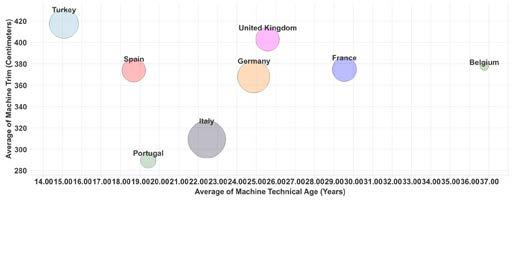
The same comparison set is used in Figure 10 to benchmark the average production cash cost for each country. The width of each country’s bar represents the relative size of production. Spain is in a good cost position with only Portugal having lower costs. It’s important to note however that Portugal has a much larger amount of integrated fbre and lower market pulp costs than Spain. This explains a lot of the cost diferences seen in the Iberian Peninsula. Italy and France are very similar to Spain. Germany has higher energy costs but tends to use more low-cost recycled fbre. Higher energy costs in the United Kingdom and Turkey push these countries to a high-cost position on average.
Production costs only provide a snapshot of the industry viability over time and can be misleading in times of economic disruption. Figure provides a view of the next fve years using Fisher’s Viability Index, which was used to combine cost position and asset age with additional competitive factors. Portugal and Spain also lead the comparison set in this metric as well. However, Turkey moved to a number three position, partly due to its new machines.
Figures 2 and take a deeper dive into the energy efects on a country’s competitive position. Figure 12 is the cost of energy per ton of tissue production for each country. The bars are coloured to indicate on-site production energy from fuels and electricity

PRODUCTION COSTS ONLY PROVIDE A SNAPSHOT OF THE INDUSTRY VIABILITY OVER TIME AND CAN BE MISLEADING IN TIMES OF ECONOMIC DISRUPTION.
FIGURE 11 PROVIDES A VIEW OF THE NEXT FIVE YEARS USING FISHER’S VIABILITY INDEX, WHICH WAS USED TO COMBINE COST POSITION AND ASSET AGE WITH ADDITIONAL COMPETITIVE FACTORS. PORTUGAL AND SPAIN ALSO LEAD THE COMPARISON SET IN THIS METRIC AS WELL. HOWEVER, TURKEY MOVED TO A NUMBER THREE POSITION, PARTLY DUE TO ITS NEW MACHINES.
Country Report: Spain CR
Tissue World Magazine | January/February 2023 16
Figure 10: ain o arison et ash ost
Figure 8: Spain Tissue Finished Products
Figure 9: Spain Tissue Machine Quality
purchases. France, Portugal, and Spain are currently in a low-cost energy position. However, it’s important to keep in mind that this is a snapshot of the current energy supply disruption, and it may need to be revisited in a few years.
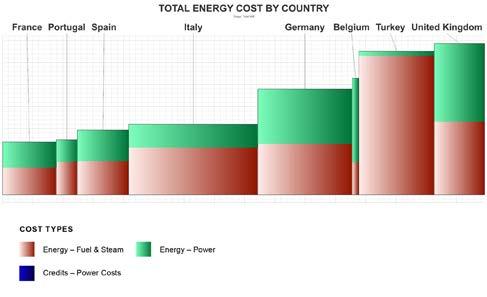
Figure 13 shows the same energy consumption rate, but energy units, or GJ, are substituted for the cost to get a comparison independent of current energy pricing in each country. Spain retains its favourable position, but Turkey moves from last to frst in energy consumption. Some diferences refect the efciencies of the sites, but others can be explained by the grades produced and the technology used.
Figure 14 shows the average scope 1 and 2 carbon emissions per ton of production, representing the same energy consumption in Figures 12 and 13. France leads with the lowest carbon emissions due to the nuclear electric grid, but Spain comes in at second place. Turkey and Germany have signifcant coal energy inputs that drive emissions higher and places them as some of the larger emitters of this comparison set.
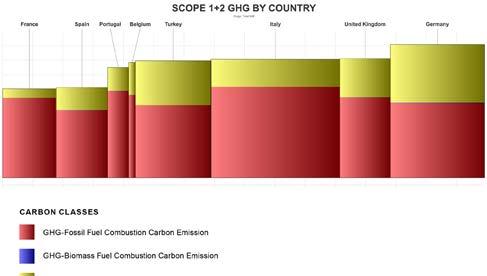
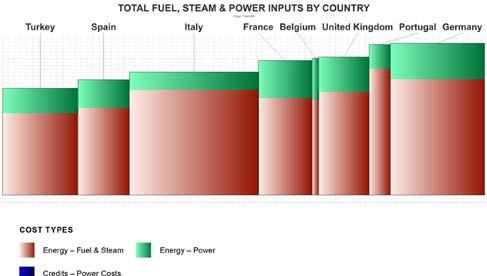
This analysis looks at a snapshot of Spain and western European tissue-making based on country averages in an extraordinary time of energy price shocks and supply chain disruption. This crisis will pass eventually, but it is unclear when or how the tissue business across Europe will adapt.
Spain's domestic tissue production capacity continues to be in good shape. Imports and exports remain in balance and capacity additions continue to be measured to replace older and higher-cost tissue machines without oversupplying the market. The country depends on market pulp imports but has maintained a good cost position relative to its peers. Also, its carbon emissions are lower compared to the rest of the competitive set, except for France.
Population growth has resumed, but the long-term population is still expected to contract slowly. Consumer purchasing power has grown recently. The impact of out-of-ofce work opportunities and Spain's preferred climate may result in further immigration gains, but this is unlikely to ofset the low birth rates completely.
Analysis of competitive position requires specifcs on tissue producers and individual machines. This article presents a static picture summary of Spain's tissue industry today. Fibre prices, exchange rates, and environmental regulations will change, providing some participants with advantages and others with new challenges.




Spanish tissue mills will continue to change hands and perhaps consolidate; neighbouring countries may invest in tissue-making capacity, thus afecting the country’s imports and exports.
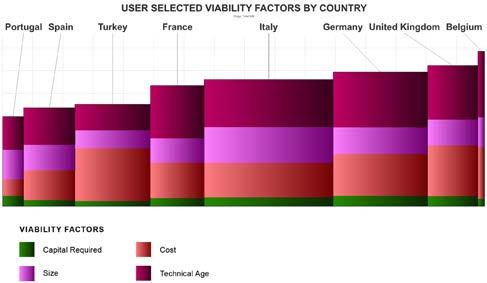
Country Report: Spain CR
Figure 11: ain o arison et iabilit
Figure 12: ain o arison et Ener oat er on Euro
Figure 13: ain o arison et Ener G er on
Tissue World Magazine | January/February 2023 17
Figure 14: ain o arison et o e an 2 arbon E issions MT CO2 eq/FMT
POPULATION GROWTH HAS RESUMED, BUT THE LONGTERM POPULATION IS STILL EXPECTED TO CONTRACT SLOWLY. CONSUMER PURCHASING POWER HAS GROWN RECENTLY. THE IMPACT OF OUT-OF-OFFICE WORK OPPORTUNITIES AND SPAIN'S PREFERRED CLIMATE MAY RESULT IN FURTHER IMMIGRATION GAINS, BUT THIS IS UNLIKELY TO OFFSET THE LOW BIRTH RATES COMPLETELY.
SPAIN BALANCES ITS PRIORITIES IN SEARCH OF PROFIT MARGIN RECOVERY
already contracting pre-pandemic due to shrinking consumer demand out of sustainability concerns and key suppliers’ SK withdrawal, sufered further volume loss in 2022 at -2. .
volume, benefting largely from the gaining strength of the hospitality industry. Despite price increases, premium oferings that emulate cloth napkins and provide enhanced comfort have gained attraction.
Elevated infation has put Spain’s tissue industry to test in 2022 in a somewhat Dickensian fashion, looking to be a tale of two cities, with value sales receiving a boost shot in arm while volume under pressure. However, despite pricing pressure, products delivering a stronger cost-beneft proposition through valueadded innovations will likely stand a better chance of diferentiating and demonstrating resilience in Spain, where already high per capita consumption provides limited room for organic growth.
In retail tissue, a slew of supply chain crises from surging energy and commodity costs to fbre scarcity have forced players to ramp up prices, leading to a growth spike in value sales 2022, according to Euromonitor International’s new preliminary data (to be released in February 202 ). However, outsized pricing pressure has weighed on consumers’ ability to consume even common necessities such as tissue products. In 2022, retail tissue volume consumption slid by 0. .
The volume drop can largely be attributed to losses in toilet paper and paper tableware, which posted the largest volume decline in both absolute and percentage terms in 2022. Toilet paper, the largest tissue product accounting for nearly half of category total, saw volume contract by - .2 . Meanwhile, paper tableware,
Such infation-driven value-volume dynamic was also present, though to a lesser degree, in the AfH tissue sector in 2022. Similar to retail tissue, AfH tissue’s value sales reached a record-high growth rate of . Though volume sales tracked an upward trajectory, the pace of growth slowed slightly compared to 202 . That decelerated volume growth was due in part to many businesses’ margin-defending shift to lower-quality, thinner products such as single-layer tissue.
Nonetheless, AfH tissue had a more positive run in 2022 supported by relaxed restrictions and improved economic activities such as tourism and consumer foodservice. For example, Spain’s number of inbound trips, particularly leisure trips, in 2022 was expected to increase by nearly 0 , according to Euromonitor’s Travel research data published in August 2022, while consumer foodservice sector was estimated to expand by by count of transactions in 2022, according to Euromonitor’s new preliminary Consumer Foodservice research data (to be released in February 202 ). Of all AfH tissues, napkins experienced the strongest growth in both value and
r her o d e o hare of retail tissue market

While infation has posted considerable challenges for all businesses, it has created opportunities for some, particularly the private labels, as consumers sought cheaper yet reasonably quality products.
Indeed, consumers belt tightening has led to increased willingness to further commit to private labels that present quality of products competitive to name brands’ and gain further retail exposure through expanded physical retail channels such as discounters and supermarkets, which made up 2 and of total retail tissues sales in 2022, respectively. Most notably, supermarket chain Mercadona, the largest private label tissue supplier in Spain with 2 of market share, continued to outperform competitors with the strongest share and percent-point sales increase in 2022.
Overall, in retail tissue, private labels grew in value sales in 2022 to reach nearly in market share, up from in 202 . Given such momentum, Spain has surpassed Germany in 2022 to have the strongest private label presence in retail
Tissue World Magazine | January/February 2023 18 Country Report: Spain CR
r a e a
e
Liying Qian Head of Tissue and Hygiene, Euromonitor International
o ahead o er a r a e a e re e e e er ro e e e e e h a a d a e er or a e ad a o a o a d a a dr a e o e e ed e © Euromonitor International 1 Spain,
% Y-on-Y growth -3 0 3 6 9 12 2019 2020 2021 2022 2023 (fc) 2024 (fc) 2025 (fc) 2026 (fc) 2027 (fc) Volume, yoy % growth Nominal value, yoy % growth Source: Euromonitor International
retail 3ssue, y-on-y growth, volume (‘000s Tonnes) vs nominal value (Retail rsp, EUR million, fixedexg-YrCurr), 2019-2027
Messe Düsseldorf, Germany
THE WORLD’S LARGEST DEDICATED TISSUE INDUSTRY TRADE SHOW
The European edition of Tissue World is the only dedicated event for tissue manufacturers and suppliers in central Europe.
In 2023, the fagship show will make its stop in Düsseldorf for the very frst time! A mature tissue market with high private label shares, Germany is home to some of the sector’s largest private label manufacturers.
Tissue World is setting up there, ready to welcome back thousands of industry professionals for three days of trading, learning, and networking.
Don’t miss your chance to unite with the global tissue industry at our inaugural event in Düsseldorf from 28-30 March 2023!
www.tissueworld.com/dusseldorf tissueworlddusseldorf@informa.com
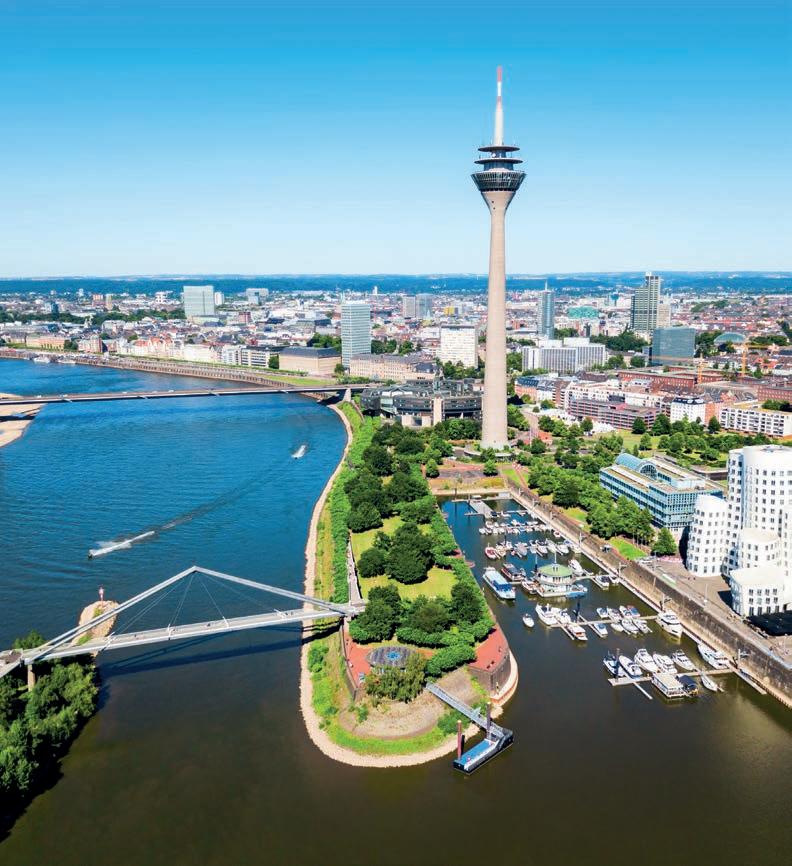
28 - 30 MARCH 2023
Portfolio Offcial Magazine Organised By
NEW LOCATION
Spain, away-from-home 3ssue, y-on-y growth, volume (‘000s Tonnes) vs nominal value (msp, EUR million, fixed-exg-YrCurr), 2019-2027
tissues are gentler, more absorbent and dermatologically and ophthalmologically tested with no fragrance, ink and dye. They also beneftted from receding pandemic restrictions on AfH activities as well as consumers’ appreciation for convenient tissue products suitable for on-the-go occasions.
As infation pressure eases throughout the next fve years, the entire tissue market’s growth pattern will normalise, with value growth softening and volume growth strengthening. Growing population and consumer living habits, including enhanced personal hygiene maintenance routines, will further shape category growth.
However, on the product level, the path to normalization will be uneven, with paper towels and facial tissues expecting the strongest growth in both retail and AfH in the following years.
a e rea o hro h o a
a d a a ro de e d ere a o
Though margin recovery is a top priority in the near term that requires cost saving and pricing increases, in the longer term, valuebased innovation across the price ladder will help tissue businesses deliver more meaningful, positive impact on consumers and grow their share of consumer wallets. While maintaining products’ availability and accessibility remains key, tissue players, including private label manufacturers known for value positioning, will continue to explore premiumisation opportunities in high-growth, high-margin product segments and vie for growth through shopperresonating innovations. This strive for value creation and to deliver higher cost-beneft ratio in products will be manifested in both retail and AfH tissue.
tissue in Western Europe. However, it raises the questions of if private label’s market penetration is peaking and how much further it can go by pulling common levers such as pricing after this crisis.
a er o e a d a a e a a re h e e e a ed h e e de a d
Despite infationary headwinds, not all tissue products sufered from declining consumption in 2022. Paper towels and pocket handkerchiefs were two exceptions in retail tissue seeing expanding appetite, beneftting from intensifed hygiene awareness and cleaning routine.
For example, paper towels, which despite
unit price growth, saw volume growth slightly stronger than in prior years, from 0.2 to 0. . Per capita consumption of paper towels also inched slightly upward. Such performance demonstrates the enduring demand for a healthy, hygienic lifestyle.
Pocket handkerchiefs, despite their small size, also tracked positive volume growth in 2022 due in part to increased oferings promoting health-focused, safety-reassuring properties. For example, following its launch of Kleenex Allergy Comfort boxed facial tissues in 202 , Kimberly-Clark introduced the pocket variation that is designed to ofer comfort from runny noses and watery eyes. These
Development of paper towel, a key multipurpose cleaning solution, is expected to shift further towards higher durability with performance-lifting characteristics, such as added soap, water resistance and special texture.
Sustainability will further rise to become a key competitive edge, with more businesses seeking certifcations and launching greener tissue products using recycled sources and alternative fbres, including cheaper options such as recycled and unbleached toilet paper and paper towel.
After all, as businesses weather this period of high infation, striking a keen balance between quality and value while recovering margin through performanceforward innovations will remain a priority.
Tissue World Magazine | January/February 2023 20 Country Report: Spain CR
Country
Spain CR © Euromonitor International 2 0 100 200 300 400 2019 2020 2022 2027 (fc) 2019 2020 2022 2027 (fc) 2019 2020 2022 2027 (fc) 2019 2020 2022 2027 (fc) 34 3 31 30 2 29 1 57 9 61 6 64 1 61 102 3 97 4 96 5 3 3 329 76 326 06 331 79 316 21 1 0% 2021-2026 C R -1 2% 2021-2026 C R Toilet aper aper Towels aper Ta leware 0 2% 2021-2026 C R acial Tissues 1 6% 2021-2026 C R Volume performance y retail 3ssue su -category, 2019 2020 2022 2027, Spain Retail volume sales, ‘000s Tonnes Source: Euromonitor International © Euromonitor International 3 Spain, ey 3ssue players sales, 2022 2021-2022 % growth 2 21 5 41 60 5 0 Retail value (rsp, EUR million) 0 300 600 900 1200 rivate a el Essity Inter I E Systems V 2022, value sales (retail rsp, million EUR) 2022 % value share 2021-2022 % growth in value sales Source: Euromonitor
© Euromonitor International 4
% Y-on-Y
-16 -12-4 0 4 12 16 2019 2020 2021 2022 2023 (fc) 2024 (fc) 2025 (fc) 2026 (fc) 2027 (fc) Volume, yoy % growth Nominal value, yoy % growth Source: Euromonitor
Report:
International
growth
International
AFTER THE ‘BIG EVOLUTION’ THE MARKET IS STABILISING AGAIN
Spanish consumer tissue leader Essity Valls met the turmoil of recent years with its own rapid response. Miriam Guasch, Operations Director Manufacturing Spain, Global Supply Chain, charts how the industry has changed. TWM Senior Editor Helen Morris reports.
Speed velocity are the words Miriam Guasch uses frequently throughout our interview. Having joined Essity in 2000, she took on the role at the global health and hygiene giant’s Spanish fagship Valls facility in anuary 2020 – just a few months before the outbreak of Covid-19.

Immediately, necessity became the mother of invention: “In a very short time, there have been a lot of changes,” she says over a Microsoft Teams call from Essity’s Valls facility. “I started my new role as Operations Director in Iberia just as the pandemic was starting, and I have never in my previous experience seen so many speedy changes were needed in those frst few months. There are now more and more macro indicators that have resulted in a big evolution of the market, and the businesses that operate in it. The market has taken on another level of speed velocity. It has grown very rapidly.”
Guasch highlights the company’s products as “basic needs, basic necessities”, and following the pandemic says they had suddenly become “a very fashionable product”.
Operation Report OR
“At the beginning, you saw everywhere that the trend product was toilet roll”, she says. “Bathroom tissue was everywhere. It also became very clear that toilet paper was a psychological product. Psychological studies carried out following the pandemic have shown that in times of need, there are certain products that ft the worries of the people. As we saw with the stockpiling, toilet tissue is one such product that fts because it is not an expensive product, it is quite big so you can fll your storage at home, and it fulfls your daily needs. Most importantly, it seems to bring people the feeling of comfort and security.”
TWM frst visited the Tarragona-based Valls plant almost ten years ago, for the Dec 20 2 an 20 magazine. Located an hour and a half drive south-west from Barcelona, it was established in 1951 as a family business and acquired by SCA in 1998. Then site manager Toni Mata had discussed the company’s uly 20 2 acquisition of GeorgiaPacifc’s European tissue business, with SCA purchasing the Spanish-based Allo, Canary Island, Sant oan Desp and Carmona sites, which had just gone through in uly 20 2. The company, he said, had “seen a gap” in the Spanish consumer market.
Now in February 202 , the range of technology the business has at its three Iberia-based plants – Valls in the provincia de Tarragona, Cataluña, Navarra in northern Spain, and a plant in the Canary Islands – has expanded according to his vision.
The three sites have four paper machines from PMT and Beloit, and 0 converting lines supplied by Perini, Futura, Bretting, MTC, Gambini and Omet. Across Spain, the company’s market share is mainly consumer goods, with 90% consumer goods and 10% professional hygiene.
Spain is now the leading producer of private label tissue in Western Europe, and Guasch says the fgure stands at - 0 for Essity Valls’ production.
Is the high rate of private label products due to the pandemic? “No, it has been like that for many years. A lot of it is a result of the economic crisis we have had in Spain over the past few years. We have seen a lot of customers in other regions (countries) change from brands to private label, but it’s not the case here in Spain, we have always had a very high private label market.”
The trends that have emerged from the pandemic are fast changing supply networks – that speed velocity, which in particular has also changed how consumers have been buying products.
“In just a few days after Covid-19 started,
we were forced to quickly change our supply chain, and to work in a new environment that was safe. There had been no prior experience or guidelines for this, and I am very proud of the people I am working with and how we managed to accommodate all the necessary changes. We managed to run everything without stopping and without incidents. It was fantastic.”
More and more consumers also changed their way of buying: “We saw that consumers started to buy more and more products for home solutions, as they were spending more time at home, and people were buying more products for cleaning, etc. And then after the pandemic, we have had substantial increases in the price of energy, it has increased a lot, and as we are an electric and gas-intensive industry, this has forced us to work with customers to transfer some of these costs to the customer, and also to the end consumer. This has also resulted in trend changes. It just isn’t manageable for any paper producer to absorb these type of energy prices, and there has been an incredible explosion of prices.”
The price of the product in the shopping cart has also increased: “We have seen that the customer has changed the way of buying, they have started buying products with a smaller format. In the past, we were used to selling big packs, now we sell smaller packs. So, they are now buying more often but smaller packs. Customers have also been buying closer to home, but now the market is stabilising again, and consumers are going to the supermarket and buying again as usual.”
Guasch says the Spanish tissue market is very much still growing but adds that speciality products are not growing as they were. The company’s strategy is to continue to work in products that are sustainable. An example, she says, is the company’s Spanish brand Colhogar, and the ‘Colhogar Paper Kitchen Adapt’/ Para Todo kitchen roll product.
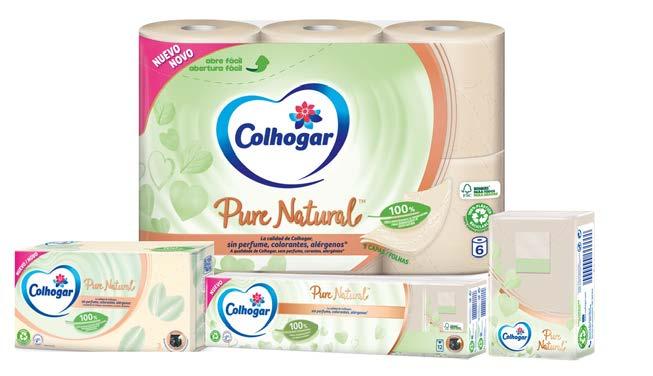
“We have invested so that we can provide a kitchen towel that has a half sheet pre-cut, rather than a full sheet. So now in the kitchen, consumers can spend less money and use less product – they can use half that of a normal kitchen towel sheet, and use just what they need. This allows consumers to make a more sustainable consumption of paper, using only what they need, and they can save
paper by using only what you need with the half-sheet system.”
In the immediate future, the company’s record on sustainability will continue to be expanded: Last year was a year when we were talking a lot about prices. Now, our aim is to put sustainable products on the table of the consumers. For the second year in a row, Essity has been included in S&P Global’s Sustainability Yearbook, a review of 7,800 companies globally, and we are part of the top 10% to be selected. So, sustainability is very much our business model.”
The means will be a three-pillar approach: “We split our sustainability working in diferent ways. One pillar is related to the investments needed to reduce energy consumption in our processes and to be more efcient but we’re also focused on investment to generate green energy investments.
A second pillar is to ofer products that are more sustainable, and the third pillar, according to Essity’s sustainability strategy is to make more from less. This way we make our processes more efcient and ensure that we use raw materials and energy in a more efective way.
Investing in sustainability and the future also means getting people on board with the necessary skill set. “We do invest a lot in talent. For many years, we have had close contact with universities, and we help the people who have the knowledge but not the practice in this industry. It’s a positive for us as well as it can be very difcult to fnd people with the necessary skill set.
Guasch concludes: “During the past few years, we have had many economic crises, and a lot of pressures, and there are organisations that forget their people. But Essity has really stepped up to help its people throughout all of them. It’s a very human company, a very people-orientated business. We will continue to build this culture, it is what has made us sustainable as a business over the years.”
Operation Report OR Tissue World Magazine | January/February 2023 22
OPEN AIR RESTAURANTS, INCREASED VACATIONING, SUNNY CLIMES: HOW THE RETURN OF TOURISM IN SPAIN IS FUELLING THE BOOMING HORECA CHANNEL... THERE AND IN THE UK
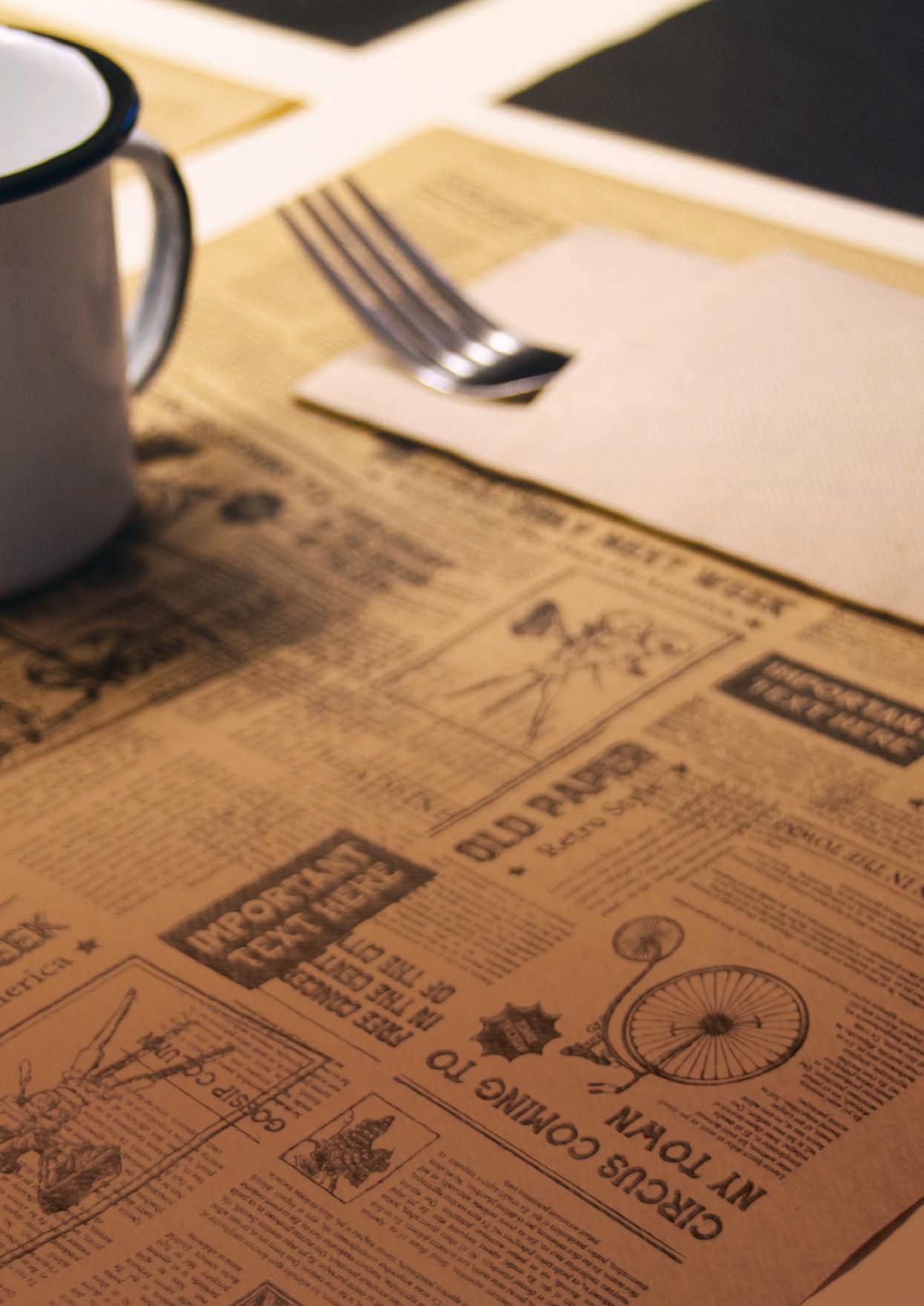
Operation Report OR Tissue World Magazine | January/February 2023 23
Two tissue plant acquisitions in Spain by the UK-based Northwood Group have seen a double win … the Spanish market’s continued recovery, and a solution to a potential Brexit supply chain problem. TWM speaks to Northwood Group Chairman Paul Fecher and Northwood Dicepa and Northwood Manipa’s Managing Director Juan
Mor.
Local supply has always been vital for the family-owned, paper hygiene products leader Northwood Group, with its manufacturing headquarters in Telford, UK. Then along came Brexit, and then Covid, infation a war in Europe and the energy crisis and the company’s ‘think global act local philosophy’ became more important than ever.
Over a Teams call, Northwood Group Chairman Paul Fecher and Spain-based Northwood Dicepa and Northwood Manipa Managing Director Juan Mor outline in detail just how the events of the past few years have cemented their business strategy. “Brexit and Covid have highlighted to everybody that a local supply, and a quick delivery, are essential,” Fecher says. “At the time it was largely a result of the upcoming Brexit that we took a decision to manufacture even more products locally in the UK, simply because of all the extra complications that would come from Brexit.”
The business was fortunate that it had acquired Enate-based Dicepa Papelera and Madrid-based converting plant Manipa in Q4 2019: “It was perfect timing,” Fecher says. “It was literally just before Covid, and a very strategic move for us at a time of uncertainty just before Brexit. In the same period, we had also acquired the

Chesterfeld Paper Mill and the Oldham converting plant with its fully equipped hand towel production unit. We knew the Dicepa business very well and our relationship with the Mor family goes back longer than 20 years as we have been the UK agents and a major client for Dicepa for a long time, so it’s a very secure relationship. This meant that the purchase was a smooth process and we could serve the local markets in Spain and the UK, but also trade more smoothly into Europe, cutting down on all the bureaucracy that has occurred in the last few years.”
Established in as a Paper Mill Agency, Northwood Paper, Tissue and Hygiene Group is now a market leader across the European continent with a fully integrated paper hygiene ofering. It manufactures and supplies professional paper hygiene products, brands, private label, as well as a full range of folded and rolled hand/wiping products across the AfH sector and ofers the consumer sector the full range of toilet, kitchen, facial tissue consumer customers own branded products.
In the UK, the Northwood group of associated companies and their production plants are located strategically across the country. Most recently in December, Northwood completed the acquisition of the trade and assets Consuma Paper Products – now rebranded as Northwood Consuma Tissue (NCT). The company manufactures customer’s own brand of
facial tissues, pocket packs, household towels and premium toilet paper, and the move completed the full range of products that are needed to serve the main retailers in the UK and Irish markets.
A new high-speed toilet and kitchen tissue line is shortly to be commissioned which will increase the quantity of rolled products the company will be able to supply as it extends its close collaboration with the solid customer base of Northwood Consuma Tissue. The fnal part of the expansion programme will be the 0,000mt tissue machine to be installed in the company’s Disley Tissue Mill. Further update on that will be available during the coming months.
The company’s 2019 move into the continent has brought additional recycled paper production, and further increased the supply of the converting papers needed by the Northwood companies. Crucially, it also gave the wider Northwood Group fresh access to the Spanish and mainland European markets. The Enate-based paper mill is now pursuing opportunities to expand its product portfolio, while the Manipa converting operation has expanded with an OMET converting line which was installed in 2022, ofering a wider range of products.
Was the move into Spain a reaction to Brexit? “A presence on the continent has always been very important,” Fecher says. “But yes, Brexit at the time was very much in our conscience and it made sense to have a foot inside the E . Also our work in the K, expanding some of our folded hand towel product production meant that the paper
Operation Report OR
Fully renewable energy: Northwood Dicepa has worked to reduce the production of fossil fuel-based feedstock, including advanced plans to install a biomass plant and more solar panels
mill in Spain is the base paper supplier for what we convert here in the UK. It was a very good ft.
Northwood Hygiene – which provides brands for the AfH professional hygiene and wiping market – now consumes a lot of the paper made by Northwood Dicepa, and Fecher says that will continue to expand further.
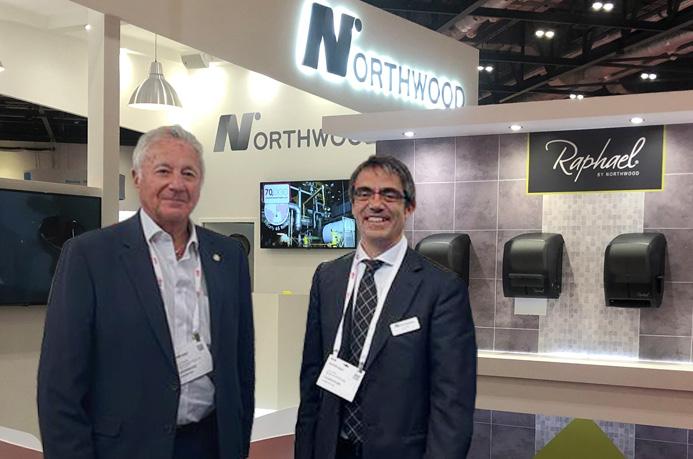
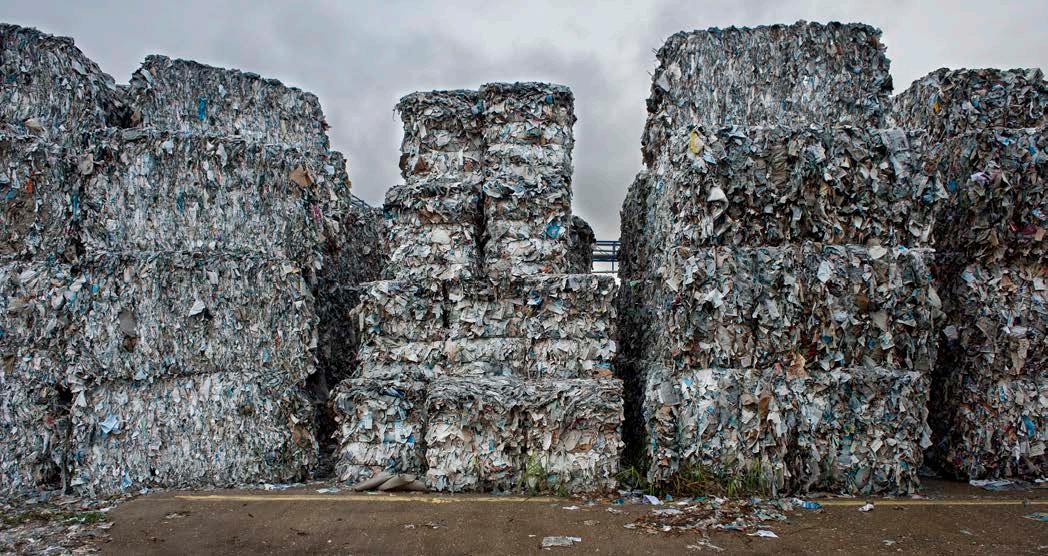
There are also plenty of opportunities for further growth, both organic and by acquisition. “Not all opportunities presented are the right for us, but we are always looking at organic growth or growth through acquisitions. We’re in the right sector, demand for Hygienic papers is still growing. The fast-food sector, Table Top, HoReCa sectors are still growing, especially in Spain and we are investing there with the additional large napkin line already running and also converting lines for rolled products. People are travelling and vacationing, we are all returning to pre-Covid habits and we’re very much entrenched in the whole sector. There’s room for growing our footprint and certainly we will need additional equipment especially in Northwood Manipa. Further investments will take place, and opportunities are always evaluated as they come along.”
The company’s Spanish plant manufacturers heavier base papers, a substantial amount of which is for the hygienic sector. “Over 50% of the business goes into either the hygienic sector or the food sector,” Mor says. “Placemats, table
covers and that fts nicely into what is converted at Northwood Manipa in Madrid.”
“The return of tourism has created a big boom for tissue and allied products in Spain,” Fecher adds, “The AfH market has rebounded. Looking at our own numbers’ year-on-year, Manipa’s business will double in the 18 months from mid-year 2022 through to end 2023, and a lot of that will come from exporting across Europe and beyond. That’s in volume terms, fnancially speaking infation has meant we need a new calibration to evaluate how a business has evolved. We have also purchased new machinery, our napkin production will more than double as we started-up the newly
installed OMET line. We will also have some new roll products converting lines installed still in Q1 2023.”
How many million napkins do they make in a month? “We make 120 million napkins per month now. And soon we are ramping up production that will more than double that number!”
The downturn in the HoReCa market during Covid, the company took the step to grow the Northwood Manipa business and in the second half of 2020 it moved into a new facility, two and a half times bigger than the former factory. “Back then of course we were in Covid, which was an interesting time to make a big step,” Fecher
Operation Report OR Tissue World Magazine | January/February 2023 25
Recycling boost: The company’s 2019 move into the continent brought additional recycled paper production, further increasing the supply of the converting papers needed by the Northwood companies
L-r: Northwood Group Chairman Paul Fecher, and Northwood Dicepa and Northwood Manipa’s Managing Director Juan Mor, showcasing Northwood Hygiene Products’ UK propriety brand Raphael
says. “But there were also opportunities. We entered the PPE feld because demand was there, we were able to respond very quickly, both by buying machinery that could make some of what was required, and by sourcing because of the supply chain network Northwood has all over the world. We also converted in the early days of Covid some of the napkin machines to manufacture a very simple PPE product.
“We were very agile and for that to happen at that early stage having bought the company in Q4 2019 could only happen because due to the existing relationship and good understanding we have with Juan and the team, that meant we could reach conclusions very quickly.”
The business then had time to settle into the new facility as the main market for napkins and table covers fell of the clif during 2020 and a good part of 2021. “But we were able to build enough stock running intermittently to keep everyone employed, and the subsectors somehow carried on as people were eating outside and that meant that the restaurants were still operating in Spain, France and southern Europe and of course people were taking take away … all of which required paper goods.”
Demand for the company’s paper mill during the period was consistent, as hand washing and wiping all surfaces demanded wiping papers. “At the same time – which is perverse really – during this huge pandemic, we had the love and hate relationship with plastic and plastic packaging accelerating, and so for the frst-time paper was perceived as a sexy industry Everyone loved toilet and towel manufacturers, we
were in the news and social media”.
The Northwood Dicepa paper mill has made eforts to reduce the amount of fossil fuel-based feedstock: “There are advanced plans to install a biomass plant and more solar panels, this will allow the mill to operate fully on renewable energy,” Mor adds. Historically the mill has worked with hydro and solar power and has an efcient CHP plant, and he says importantly for the fnished product side, 0 of all its prime packaging materials “are free of polycarbonate based flms .
New products have also been developed to help the company’s clients reduce their costs. “We’ve been using new raw materials that make it possible to reduce by 6% the water we use and save more than 11% on usage of energy,” he says. “We have tried to be very agile and respond quickly, proposing new ideas and being proactive to help our clients.”
Within the whole sector, there’s been “a lot of product engineering innovation, everyone is looking at specifcations , Fecher adds. “Companies are asking now if the paper is more robust, are the base weights that they used to use the right ones, or can they be modifed without sacrifcing performance. A lot of that background work with customers and the markets has also been taking place. It’s a continuous improvement process.”
The company is also seeing an opportunity for growth in its private label products in the Spanish market, as well as its brands. Private label now makes up almost 50% of its Spanish fnished products and Fecher sees this

increasing over the coming years. “With the technology we have in the UK it means that our private label products are a brandmatch. Having said that, we do also have brands specifcally in the napkin market, the technology competes favourably on performance with top brands most of which are made on energy intensive machines our products are made on standard base papers, our Morigami Napkin range the enhancement is on the converting line. Additionally, some of the UK propriety brands (Raphael, North Shore, Optimum, Whisper, Rhino) from Northwood Hygiene Products which have sizeable market share in the UK are now being rolled out to our customers in Spain, and further afeld on the continent.”
For 2023, he concludes that the key opportunities for the business remain continuing to serve the private label sector as well as taking advantage of the fastgrowing food sector. “We can now respond in the UK and across Iberia, which is a big advantage. It can be summarised is that most people – even before the interest rates started going up – were conscious of stock levels, and if you run an efcient operation, you need a supplier that is nearby. That has really worked in our favour because we can now respond to local delivery, in the UK and Spain, and it’s a delivery in days rather than weeks and months. The events of the past few years have highlighted to everybody that an efcient and responsive local supplier is essential, and we have steered the Northwood Companies to be that supplier of choice on quality, service and economics.”
Operation Report OR Tissue World Magazine | January/February 2023 26
Continuous improvement process: n rease attention to ro u t en ineerin inno ations an s e if ations ha e o urre a ross the hole se tor

• • •
TWM/1: How has your growth strategy as a business changed during the past few years?
During these past fve years the group has enlarged its production capacity mainly at its converting plant by up to the current 0,000tpy, which also matches the current capacity of our two existing machines at the paper mill plant.
This has been mainly due to the recent investment of two new and last generation technology lines at our converting plant.

Our main focus continues to be related to tissue in the AfH market, and we will keep some B2B activity as well.
TWM/2: And in the past 18 months?
The last months have been especially complicated due to several uncertainties afecting our business following the last stage of the pandemic, energy crisis, and the Russia- krainian war.
et in spite of all those issues we were still able to achieve two digits growth both during 202 and 2022 with our converting products.
TWM/3: What changes as a business have you made in terms of sustainability?
The continuous search for sustainable products is also strongly increasing, both as a tissue business and more and more retailers and consumers are also requesting these products. Now, companies are aiming to operate even more efciently by using recycled waste and with a low carbon footprint.
As a company deeply involved in environmental matters and having sustainability as the main characteristic of our identity, there are many actions that have been performed and many other still ongoing.
We can highlight that we have reduced water consumption since the start of the activity in 20 .
In the shorter-term, we have some big projects ongoing that are mainly afecting our plant’s energy efciencies, and they will help us to signifcantly reduce our emissions. We also have a big focus on changing the packaging of our product into more sustainable ones.
TWM/4: What plans do you have now to grow in the next few years?
Our plan for the next three-fve years is to consolidate our presence in the Iberian AfH and B2B markets through an organic growth. To do that, some investments are already been foreseen in both, and we will increase our converting capacity and also further enhance our efciency at our paper mill.
On the fnished good side, in the Iberian market we are present only in the AfH channel, where we have a wide distribution
network based on the main national and local dealers, as well as an indisputable positioning in the value-added segment. This presence remains a vital growth outlet for us.
TWM/5: Following the impact of Covid-19 on the AfH tissue market, has the market recovered in full in Spain?
2022 has shown a full recovery of the AfH channel in the south of Europe, and we have seen pre-pandemic consumption levels.
Demand for tissue products generally has also already returned to pre-pandemic levels. nfortunately, however, it is still unstable and subject to important accelerations and decelerations.
We trust that in 202 it will be able to stabilise with more regular trends.
Operation Report OR Operation Report OR Tissue World Magazine | January/February 2023 28
“2022 HAS SHOWN A FULL RECOVERY OF THE AFH CHANNEL IN THE SOUTH OF EUROPE, AND WE HAVE SEEN PRE-PANDEMIC CONSUMPTION LEVELS.”
Lucart Tissue & Soap (Lucart T&S) is a Lucart Group subsidiary based in Artziniega in the north of Spain, running two industrial plants since the beginning of 2018. Here, Luciano López, Plant Director at Lucart Tissue & Soap, looks forward to a stable 2023.
Converting boost: The company achieved two digits growth during both 2021 and 2022 with its converting products
“AFH REVENUE TO DOUBLE IN THE NEXT THREE YEARS, AH EXPECTS SIGNIFICANT GROWTH”
With a new converting production site ready for start-up, Pau Vila, LC Paper’s General Manager, explains the new trends guiding consumer choices and the company’s innovative responses. A TWM report.

TWM/1: How has your growth strategy in the Iocal market changed during the past 18 months?
“Our company was very exposed to the HoReCa segment both directly through converted products as well as indirectly through selling parent reels to converters which were oriented at the HoReCa segment. For that matter, the Coronavirus crisis produced a very signifcant demand reduction. At that time, we decided to enter the At-Home market through our own converting (Dalia brand and third-party brands) with a clear bet on e-commerce products. This segment grew exponentially during the Coronavirus pandemic and has now stabilised, while the HoReCa segment is now fully recovered, so most of the growth has come from the incorporation of the e-commerce channel into our products portfolio.”
TWM/2: What plans do you have to grow in he e e ear
“We plan on ramping up the newly launched Fornells production site for converting in the second quarter of 2023. The output of parent reels will remain quite
stable, albeit with minor improvements in productivity and technology enhancements. Our focus is mostly in creating added value rather than pure volume growth –for the past decade we have been a very sustainability-oriented company with the ambition of occupying a leading position in the eco-friendly tissue market niche both for both AH and AfH.”
TWM/3: What growth are you seeing generally in the Spanish At-Home and AfH markets?
“In the At-Home sector, we have a direct presence in the Spanish retail market under the Dalia brand, which is our sustainabilityfocused product that uses a fully printed boxed packaging format, similar to cereal boxes.
“We also do the production for thirdparty retail brands under eco-friendly formats and production for third-party e-commerce brands with boxed formats (subscription-based models)
We expect a signifcant growth in the At-Home channel due to both the market having higher sensibility to sustainable formats and our increase in production output for this product family thanks to the launch of our new Fornells production site.”
“In the AfH market, we have a direct presence in the Spanish hygiene distributors feld under the Dalia brand, with sustainability-focused products in cardboard box packaging. A large amount of product sustainability certifcations for public tenders is required here.
“We also do the production for distributor brands in Spain and the rest
Operation Report OR Operation Report OR Tissue World Magazine | January/February 2023 29
“WE EXPECT A SIGNIFICANT GROWTH IN THE AT-HOME CHANNEL DUE TO BOTH THE MARKET HAVING HIGHER SENSIBILITY TO SUSTAINABLE FORMATS AND OUR INCREASE IN PRODUCTION OUTPUT FOR THIS PRODUCT FAMILY THANKS TO THE LAUNCH OF OUR NEW FORNELLS PRODUCTION SITE.”
LC Paper’s Besalú site in Catalona: April 2023 will see the ramping up of the company’s new Fornells converting facility
of Europe, usually complementing the existing portfolio of the distributors with additional eco-friendly alternatives to each product category.
“Again, the market has a higher sensibility to elimination of plastics, sustainability certifcations, audited carbon footprint which pushes a higher demand for such product approach. We expect to double the revenue in the AfH area in the next three years.”
TWM/4: Following the different impact of Covid-19 on the tissue market sectors, what projections do you have? Has the AfH market fully recovered?
Covid- signifcantly reduced the demand of AfH products in the HoReCa and ofces (facility management) felds due to the lack of tourism and work from home. We overcame this challenge through the launch of our e-commerce and retail products initiatives, which flled the left gap. We now see an almost fully recovered AfH market.
We also see signifcant impact over the AfH product defnitions due to the energy crisis and the infation: since the costs have increased sharply, we see trends such as replacing two-ply products for one-ply products, products with controlled dispensing (sheet-by-sheet) and the growth of alternative fbres such as unbleached recycled from post-consumer cardboard boxes. Our share of private label over third-party brands and our own Dalia brand has remained stable.”
TWM/5: What trends generally are you seeing
in the local At-Home market?
“In the At-Home market there is a clear trend towards the reduction of content
(lower sheet count, lower roll count), particularly amongst the private label products, due to the sharp increases in costs derived from the energy crisis and pulp cost increases.
“On a longer-term basis, we are seeing increased attention to packaging formats and materials as well as increased attention to alternative fbre products, with some companies adding non-wood pulps and new types of recycled qualities. We believe we have good positioning in those macro trends since we already work with nonplastic packaging for 100% of our product portfolio, and we also have successfully completed several developments of tissue qualities that use non-wood fbres.
TWM/6: What changes as a business have you made in terms of environmental efforts?
“LC Paper started ambitioning to lead the path in decarbonisation amongst European tissue producers. This path started during the Nineties with innovations and patents on energy efciency such as the integration of the steam from cogeneration directly to the hood of the tissue machines, and continued with the implementation of biomass, biomethane, on-site solar production and third-party agreements with hydroelectric plants. The company works now with 100% renewable energy and has completely eliminated plastic packaging in all the converted products.
“This aggressive vision of sustainability has allowed LC Paper to become the frst tissue mill worldwide with the B Corp certifcation, which authenticates companies with excellent sustainability and social approaches.”
TWM/7: Are you seeing an increase in gross sales of tissue and towel products? What is driving that increase?
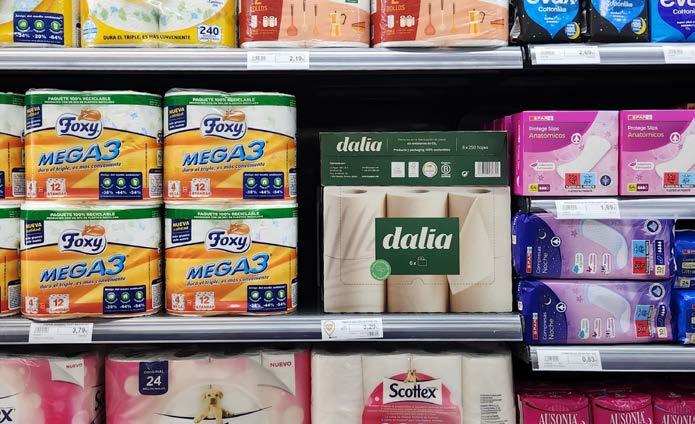
“The relative increases in 2022 and 2021 are considered by our company in the scope of the Coronavirus recovery. We don’t see higher demand than a pre-Covid scenario, but we see further opportunities to grow with value-added products which imply increasing revenues while static production throughput. Being a smaller and independent company, we need to be particularly innovative and fast to jump to the new market trends in order to avoid competing in the mass-volumes market, which would not be feasible due to the worse economies of scale of our company compared to multinational groups that have been formed through decades of mergers and acquisitions in the tissue industry. That is what drives us into concepts like the boxed packaging for AfH and the thinner boxed packaging (cereal boxes-like) for AH products, full decarbonisation, alternative energy sources like biomethane amongst other innovations.”
LC
Paper: Three production sites,
all in the Catalonia region of Spain:
Besalu site: PM3 (Crescent-Former tissue line for toilet, towel and napkins –0,000tpy) and PM2 (fat table MG kraft line – 20,000 to 25,000 tpy depending on gsm). Both parent reels machines produce for the internal converting consumption of the company (about 20% of the parent reels production) as well as for thirdparty converters (the remaining capacity). The Besalu site also has an integrated converting line for AfH toilet and hand towel rolls launched in 2018.
Fornells site: Newly launched in Q2 2023 the site contains a Fabio Perini converting line and STAX automated roll wrapper, case packer and palletisation line dedicated to At-Home toilet and e-commerce toilet. The investment has been around €3m.
Sarrià de Ter site: kraft converting (paper bags): For the company’s private label for tissue products is “Dalia” for both the AH and AfH channels and it accounts for a minority of LC Paper’s sales – it mostly produces for distributors’ private labels and third-party brands. Some 55% of the production is exported to 28 countries in four continents (2022 data). Parent reels as well as converted products are exported.
Operation Report OR Tissue World Magazine | January/February 2023 30
Sustainability-focused products: In the AfH market, the company has a direct presence in the Spanish hygiene istributors fel un er the alia bran
FROM “NO REAL AWARENESS OF THIS WONDERFUL PRODUCT,” TO CO-OWNING A GHANAIAN-BASED TISSUE PLANT PRODUCING COLOURFULLY-WRAPPED TOILET
TISSUE MADE FROM BAMBOO
As a consumer of tissue and towel products for many years now, post2017 my requirements for these products were fairly standard. I have always bought simple non-branded toilet paper because I had no real awareness of this wonderful product, nor the diversity and innovations behind toilet roll and kitchen towel products. I could say I was willing to pay a little bit more for green credentials for these retail items, but only if they were controlled and genuinely certifed.
Fast-forward to 2023 however, and it’s a very diferent story I am now a coowner of a Ghanaian-based tissue plant that produces colourfully-wrapped toilet tissue made from bamboo. And my family home and ofce The simple non-branded products have vanished and been replaced by happy, funny, and colourfully-wrapped toilet tissue rolls. I founded ‘The Good Roll’ company along with Melle Schellekens fve years ago, and since then we have sold colourfully-wrapped toilet rolls made from post-consumer recycled fbres. We wanted to make an impactful business model, and now use sheltered workplaces around the Netherlands to wrap our rolls so we can make an impact in our home country as well as in Africa.
The idea for the business was that we wanted to make a traditional product that consumers use every day a little bit ‘sexier’. That’s how our colourful wraps were born.

We started selling to the consumer market as a subscription model and are now aiming for 20,000 subscribers this year with a two till four timer delivered annually. We also sell our products into the retail and AfH markets in Europe and Africa.
It all started in a small ofce in Amsterdam six years ago and after three years of growth we had three warehouses in Weesp near Amsterdam. Originally a B2C business, we now also sell our products in the B2B and the retail space. The aim is still to be a ‘’producer’’ of tree-friendly toilet paper, and to use this as a tool to make an impact on the African continent, which is where one of our founders is from.
In 2022 we opened our own 10 ton dedicated bamboo toilet paper factory in Ghana which makes toilet roll from bamboo sticks. It’s located on a space of land that was previously jungle, and from there we realise local jobs and sell toilet paper to Europe and the local market. Through our

plant, using 0 of our net proft we are also involved in building sanitary complexes in areas where this is not currently available. We started mainly around school sites to give children the opportunity to have a hygienic toilet at their disposal.
We have a strong chosen strategy to reduce plastic across our business and we now sell more volume on one roll and use alternative fbres in paper production. Supermarkets are creating shelf space for companies like ours even if consumers must pay a bit more for the product.
We nicknamed 2020 the toilet paper crisis year . The Covid period has been a successful time for our business, and our e-commerce grew 00 in that year. We have also seen growth double in the last few years with the B2B and retail part of our business increasing during the pandemic, so much so that funding for a second 50 ton factory in Africa is now in the pipeline for the third quarter of 2023.
ConsumerSpeak CS
Good Roll’s credentials Makers of 100% European recycled paper (non-bamboo) No chlorine, colourants or fragrances In Ghana, 100% bamboo production Inspiration • 2.3 billion people with no access to safe and clean toilets • 27,000 trees cut down daily to produce toilet paper • Initiative to tackle both problems… a unique Dutch concept: a 100% tree-
toilet
Safe
clean toilets for everyone To donate 0 of net proft to
toilets
Ghana
The
friendly
roll,
made from European recycled paper
Mission •
and
construct
in
Breaking new ground: The team opened its 10 ton dedicated bamboo toilet paper factory in Ghana in 2022
Tissue World Magazine | January/February 2023 31
Netherlands-born Sander de Klerk is Founder and Chief Rolling Offcer for the Good Roll company. Here, he explains the motivation behind the team.
AUTOMATING THE INFEED OF A CASE PACKER 'A FIRST'
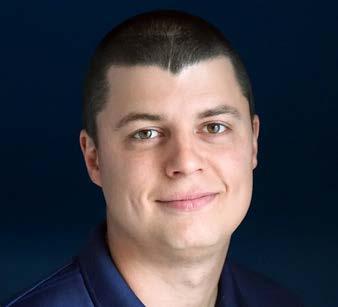
THE CONVERTED PAPER, DIAPER, AND NONWOVEN INDUSTRIES
Edson Packaging Machinery‘s KDF (Knock Down Flat) Infeed Management System targets improved space management, uniformity and
A TWM report.
With recent changing trends in the labour market, we have seen increasing interest in automating new parts of the packaging process.
Companies globally are looking to minimise the number of manual tasks on case packers for better employee utilisation. Some of these tasks involve loading the cases, removing straps, squaring them up,
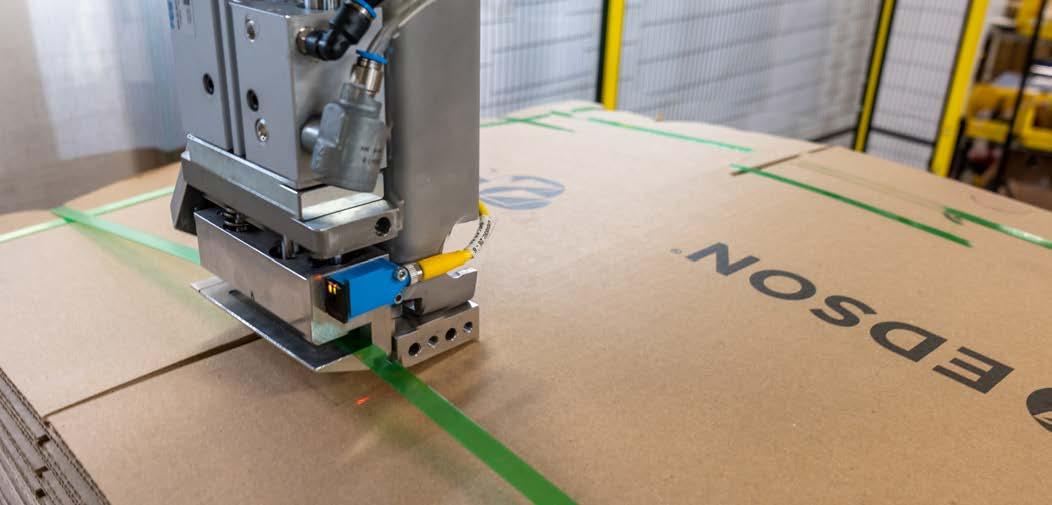
etc. The other key issue for tissue companies is consistency and cleanliness. The stacks will always come out of the cell the same, every time, and the straps, papers and dunnage are always being dropped into a bin, which is consistently requiring less frequent emptying and better space management.
In response to these developing trends, in October 2022 we launched the KDF (Knock Down Flat) Infeed Management System, which is targeted at any manufacturer currently using Edson or non-Edson case packers that feed KDF stacks into the infeed. This system is essentially available to retroft any case packer and is an option on our 3600 Series case packers (3600, 3600C, 3600HS), but in the process of showcasing the system
it can essentially be integrated with any existing case packer or equipment needing KDF preparation or bands removed.
Automation with direct product handling, wrapping, case packing, and palletising aren’t exactly new concepts. However, automating the infeed of a case packer is certainly a frst in the converted paper, diaper, and nonwoven industries. What we’ve found from talking to various people is that the usefulness of this robotic system doesn’t end with tissue and nonwovens – it can be extended to a plethora of applications.
We developed the line because we are always thinking of ways to minimise the amount of operator intervention on our
Packaging: Technical Theme TT Packaging: Technical Theme TT Tissue World Magazine | January/February 2023 32
IN
cleanliness. Josh Goulet, Account Manager, explains how.
Josh Goulet Account Manager, Edson Packaging Machinery
Extendable to a plethora of applications: The KDF Infeed Management System in action
THE ROBOTIC CELL WILL SCAN AND VERIFY THAT THE CORRECT STACK HAS ENTERED THE CELL, LOCATE, REMOVE AND CHOP THE STRAPS AND CONTAIN THE PIECES IN A BUCKET, REMOVE ALL PAPER ON THE STACK, AND REMOVE TOP DUNNAGE.
equipment. Customer demand was the main driver for development - once customers started to ask, it made it a no-brainer to start thinking about it more seriously and bringing it to life.
The system mimics what an operator would do to prepare a stack of KDFs before sending it to the case packer. The robotic cell will scan and verify that the correct stack has entered the cell, locate, remove and chop the straps and contain the pieces in a bucket, remove all paper on the stack, remove top dunnage (pieces of cardboard on top of the stack to protect the KDFs). It will continue to do this until it fnds the top of the stack. Once everything is removed from the stack, the stack will rotate, and the robot will justify each side up against a wall to ensure the stack is squared up and aligned to the downstream equipment datum. Once the stack is completely prepared it is released from the cell and enters the case packer.
In terms of R&D eforts, with innovative equipment the intent is to make it the most efcient it can be to reduce wasted energy in the form of unnecessary processes and time. For this equipment we look to use the most current electrical components which are more efcient than previous versions or alternatives and limit painted components where possible.
Preparing stacks of KDF is the last manual operation most case packers out there have. The KDF Management system removes that manual operation and allows the operators to be utilised upstream or downstream, ensuring all machines are running well without worrying about keeping the case packer fed with cases. The system can also be utilised with other equipment requiring KDF management or strap removal.
And just a last point on cleanliness; we commonly see bands/straps laying on the manufacturing foor and a forklift will drive over it and it will get caught in the wheel causing maintenance and downtime on other equipment. This system safely chops the bands into a bin for better waste management and safer working conditions. For consistency, the case packer will run with far less jamming if the stack is consistently being loaded into the case packer.
This article was written for TWM by Edson Packaging Machinery‘s Account Manager Josh Goulet.

Packaging: Technical Theme TT Tissue World Magazine | January/February 2023 33
A point on cleanliness: This system safely chops the bands into a bin for better waste management
WITH INNOVATIVE EQUIPMENT THE INTENT IS TO MAKE IT THE MOST EFFICIENT IT CAN BE TO REDUCE WASTED ENERGY IN THE FORM OF UNNECESSARY PROCESSES AND TIME. FOR THIS EQUIPMENT WE LOOK TO USE THE MOST CURRENT ELECTRICAL COMPONENTS WHICH ARE MORE EFFICIENT THAN PREVIOUS VERSIONS OR ALTERNATIVES.
‘AS ENVIRONMENTAL AWARENESS INCREASES AMONGST CONSUMERS, PRODUCT PACKAGING FACES INCREASED SCRUTINY’

THE PUSH FOR MORE SUSTAINABLE PACKAGING IS NOT BEING LED T T T CORPORATIONS HAVE RECOGNISED THE BENEFITS OF PACKAGING T T T T THE NUMBER OF CONSUMERS AND CORPORATIONS THAT PRIORITISE SUSTAINABILITY INCREASES, THE PACKAGING INDUSTRY MUST ALSO T T
Consumer research indicates that more and more people strongly consider the ecological impact of the products they buy when making purchasing decisions. As environmental awareness increases amongst consumers, product packaging faces increased scrutiny.
Product packaging can disincline ecologically motivated consumers due to an often heavy reliance on plastics and other
materials that lack a green reputation. However, the push for more sustainable packaging is not being led solely by consumers. In the tissue industry, many corporations have recognised the benefts of packaging solutions developed with a focus on the environment.
As the number of consumers and corporations that prioritise sustainability increases, the packaging industry must also
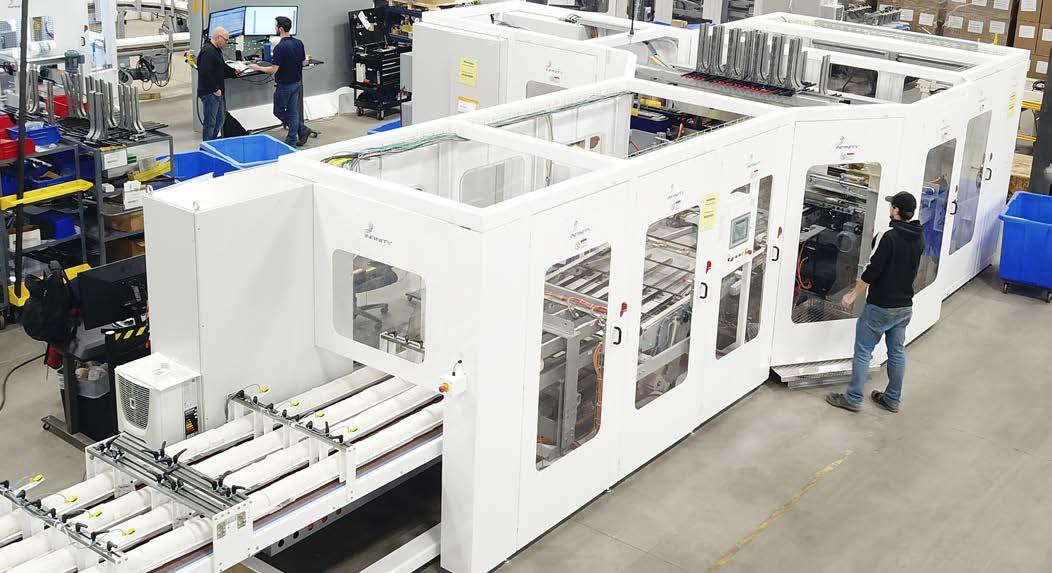
Packaging: Technical Theme TT TT Packaging: Technical Theme Tissue World Magazine | January/February 2023 34
ere re or e e ar e oord a or a h e eer or d e ho he a er a a a d o e e o o a a ade o e he o a ra e o a h er a rea red e a o o or e o er er T re or
Gregory Sense Marketing Coordinator, Infinity Machine & Engineering Corp.
Industry pioneers: nfnit en ineers ha e e elo e sustainable a a in for in i i uall ra e tissue rolls
prioritise innovative ecological packaging. Infnity Machine & Engineering Corp. has been on the forefront of innovating sustainable packaging solutions. In 2020, Infnity partnered with America’s Little Rapids Corp. to test and develop ECOVA paper overwrap, a 100% plastic free, heat-sealable paper wrap, made from 00 recycled fbre. Since then, Infnity has increased its sustainable packaging eforts and prioritised ecological design in its machinery.
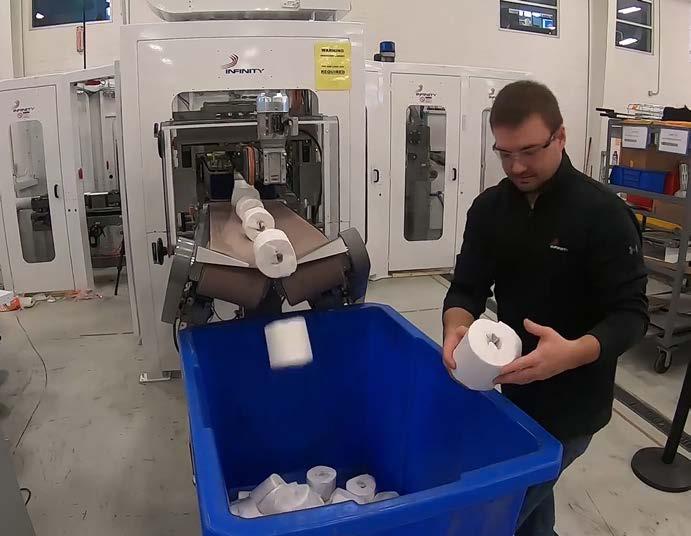
One focus for Infnity engineers has been to pioneer more sustainable packaging for individually wrapped tissue rolls. While primarily used as AfH tissue in North America and Europe, individually packaged bathroom tissue rolls are very common in the South American consumer sector. Due to the increased amount of packaging material needed to wrap rolls individually, Infnity has designed its single roll wrappers, the S2 0BRT and the S2 0HT, to wrap in paper as well as plastic.
However, Infnity’s commitment to sustainable packaging goes beyond primary packaging. Infnity’s C Casepacker is capable of loading rolls into corrugated trays. This not only provides stable secondary packaging for tissue products, but it also reduces the amount of material needed for packaging as a tray often uses less than half the cardboard of a standard case. The C can also package large-roll-towel directly into corrugated cases without the need for any additional packaging, cutting down on material cost, and material waste.
While prioritising sustainable packaging is a positive step for the tissue industry, Infnity has taken it a step further by also exploring new ways to reduce the environmental impact of tissue packaging machinery. Infnity machinery can be equipped with IE and IE rated motors, which use less power while performing at a higher efciency. Infnity is also trailing monitors on its new Vision G multipack wrapper that track the machine’s power usage and air consumption. The information that is collected will be shared with the purchaser which will allow ecological opportunities to be identifed and implemented based on the recorded data.
This article was written for TWM by Gregory Sense, Marketing Coordinator, Infnity Machine & Engineering Corp.
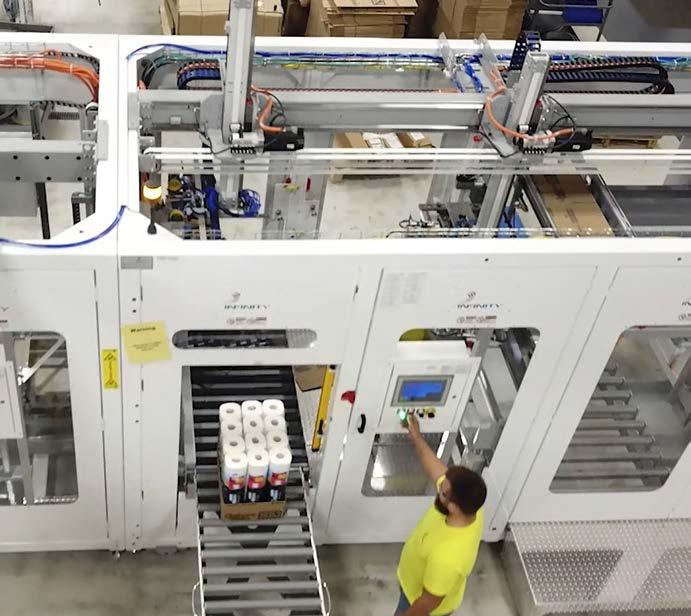
Packaging: Technical Theme TT Tissue World Magazine | January/February 2023 35
Innovative ecological packaging: he ase a er is a able of loa in rolls into orru ate tra s ro i in stable se on ar a a in for tissue ro u ts
WHILE PRIORITISING SUSTAINABLE PACKAGING IS A POSITIVE STEP FOR THE TISSUE INDUSTRY, INFINITY HAS TAKEN IT A STEP FURTHER BY ALSO EXPLORING NEW WAYS TO REDUCE THE ENVIRONMENTAL IMPACT OF T T
WITH IE3 AND IE4 RATED MOTORS, WHICH USE LESS POWER WHILE T
Cuts down on material waste: he an also a a e lar e roll to el ire tl into orru ate ases ithout the nee for a itional a a in
AI EVOLVES TO PUT SIMPLICITY AND ACCURACY INTO FOCUS FOR QUALITY PACKAGING INSPECTION
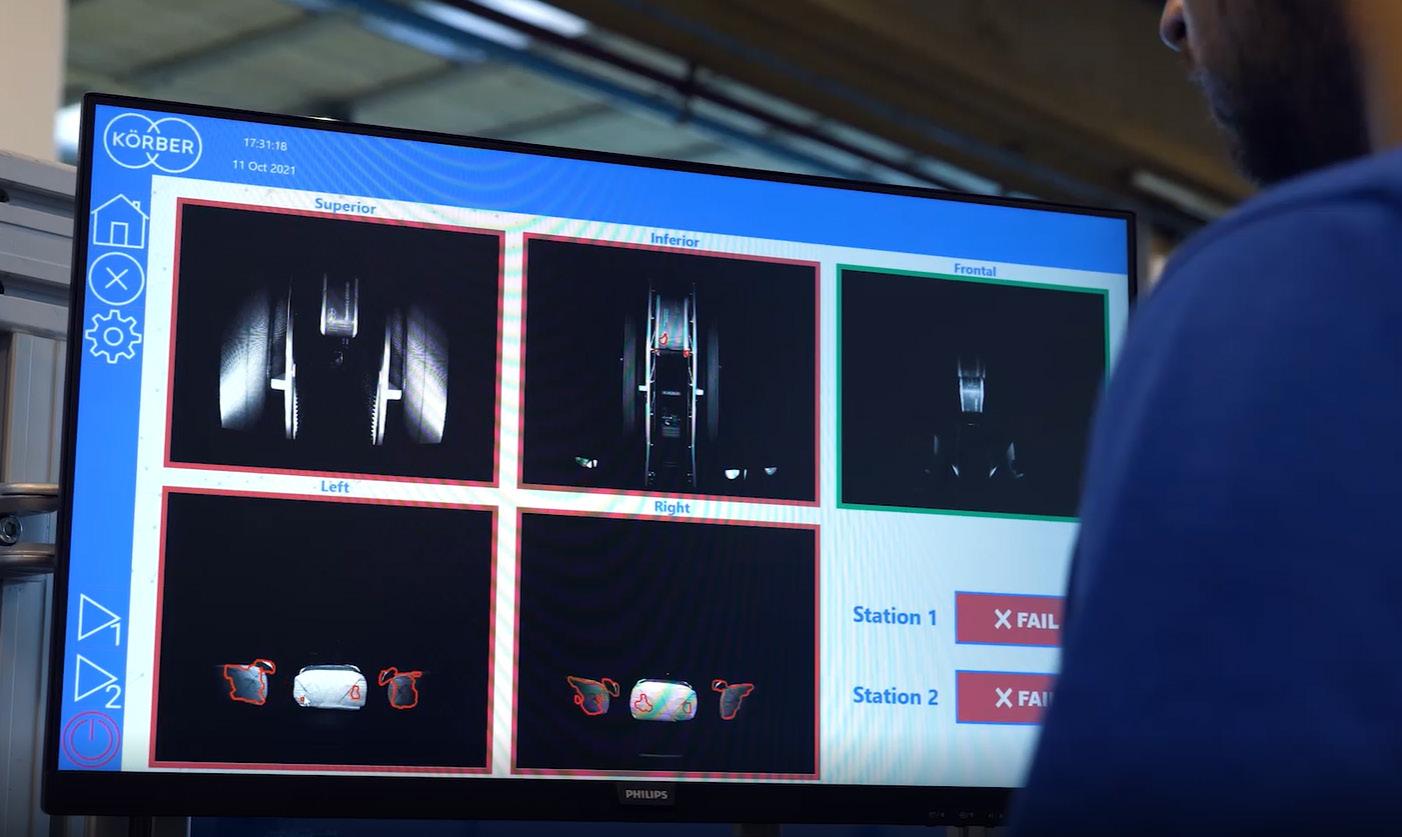

For some years the consumer economy has started to adopt and appreciate the power of artifcial intelligence (AI).
It started as a foundational technology in speech, text, and image recognition in mobile phones, progressively expanding to many other applications such as medical diagnostics, internet security, decision making, and now this same technology has matured to be applied to quality inspection and other judgment-based uses
in the manufacturing environment. Due to computational limitations of CP s, AI was not able to be adopted earlier, and now that this technological gap has been flled several manufacturing processes can beneft from a new immense power.
K rber Tissue has invested a consistent part of its R&D budget in the application of AI to develop solutions for tissue manufacturers.
The frst result is a system for quality
Packaging: Technical Theme TT Packaging: Technical Theme TT Tissue World Magazine | January/February 2023 36
r er T e ha e ra ed he a e ar a e e e o ro de he o e e e o o or r ar a a a e o o ar o rod a a er a a a d a d e ho o o o a e ra e or or a d h he re re e he o e e e o o or a a a a e o T re or
T T T T T T T T T T T T T T T T T T T T T
Nicolò Squarzoni Product Manager, Packaging and Digital Körber Tissue
The Sam Pack: rber issue s frst s ste for ualit a a in ins e tion for tissue anufa turers

packaging inspection that was launched a year ago under the name of Sam Pack. This system learns how a good sample looks, and is then able to recognise samples diferent from it given a specifc tolerance. With the same approach, Sam Pack is also able to learn to recognise specifc defects of packs such as print misalignments, side sealing defects, etc.
The core of this technology is the application of convolutional neural networks and deep learning techniques to allow an accurate and at the same time simple way to inspect packaging quality during production. This article will explain how this technology works and why it brings consistent advantages compared to both human inspection and traditional vision systems based on rule algorithms.
The concept behind a convolutional neural network is to mimic the neuron network responsible for image processing and decision-making in a human brain. The network receives as input the image to process, and it is divided into several layers, each one with specifc functions. The frst group comprises convolutional layers and is responsible for drastically reducing the amount of information stored in the pixels composing the image, leaving only the useful details that actually help to distinguish the input image and reducing the amount of data to process. This is called feature extraction.
The second group comprises fully connected layers, and they are responsible for representing in the best possible way the reference image and to decide how similar a random input image is compared to the reference. This process is called classifcation. The key of this architecture, which makes it incredibly fexible, is that each layer contains a defned number of
parameters that need to be set in order for the network to extract the right details from the image, to correctly represent the reference image and consequentially to correctly decide if a random image is similar or not to the reference.
The process to set this parameters is called deep learning. It consists in feeding the network with a set of images representing the reference, which in case of packaging quality inspection are images of good samples, and specifc algorithms can recursively set the parameters to get to a fnal confguration that performs feature extraction and classifcation in the best possible way.
This learning process can be done every time the reference image needs to change, for example changing from one pack format to another, and it just needs to scan a few good samples. Then the software updates the network automatically.
It appears very clear then that this technology ofers great advantages compared to traditional vision systems. They are based on rule algorithms, and this means that for each detail of the image to recognise, a specifc rule needs to be coded.
This solution can be efective in the case of simple images with very low variability, but in the opposite case it’s necessary that a huge number of lines of codes require high costs to create, maintain and modify, other that high coding skills. Also, for complex images, the performance of convolutional neural networks is consistently higher and it is possible to customise the decision tolerance of the network in evaluating the similarity of the image of a random pack with the reference. Comparing Sam Pack with the traditional human inspection several advantages can also be recognised, such as the stability of the inspection 2 , the reliability and moreover the speed.
In conclusion it can be observed that convolutional neural networks have been designed to feature the advantages of both human inspection, for accuracy and fexibility, and automated inspection, for reliability, stability and speed, representing the current state of the art for visual quality inspection.
This article was written for TWM by Nicolò Squarzoni, Product Manager - Packaging and Digital, Körber Tissue.
Packaging: Technical Theme TT Tissue World Magazine | January/February 2023 38
T T T T T T T T T T T T T T T T T T T T T T T T T T T T T T T T T T T T T T T T T
Convolutional neural network: a isualisation of the en ro ess
Packaging: Technical Theme TT
THE HYBRID DESIGNED TO COMBINE SPEED, BOX SIZE RANGE AND PRODUCTION CAPACITY
DIVERSA is STAX Technologies’ answer to a trend which emerged as online sales increased. Mladen Starcevic, President and Executive Vice President Tissue Packaging, explains the history of its development - and its importance for the future. A TWM report.
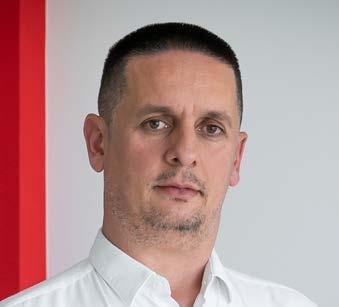
As part of the Barry-Wehmiller Converting Solutions Platform, STAX Technologies’ continuous response to customer demands identifed one of the key market developments during the recent pandemic years… more customers buying online meant they preferred smaller packages.
New ecological standards are demanding a change to secondary packaging material in the industry and across the market, which is slowly shifting towards cardboard cases. On the other side, bundling in Polyethylene (PE) is still highly used. All of this created an opportunity to design a machine that can satisfy both requirements.
DIVERSA is a hybrid machine with a highspeed bundler and case packer merged into a single machine. It is designed as one machine which does not require module exchange when switching between two diferent secondary packs.
The only thing that is required is mechanical adjustment. This machine has been optimised to increase the reliability of the packaging process and to enable production capacity of more than 20 bundles and 2 cases per minute.
All major sections have been redesigned. Layer forming and package loading are now divided into two diferent sections each with an individual elevator. Packaging into card boxes has been designed into fve distinctive phases:
Separating a single box from the stack
Case opening
Loading products into the box Flaps closing and case sealing • Closing and sealing of the cases which are integrated in the machine.
Box opening is done using a vacuum system both from the top and the bottom which open cases in a natural way. This reduces the possibility of the box remaining unopened to almost zero, and machine downtime due to this error to almost none.
Capacity of a KDF magazine is extended to more than 1,400mm with an option to load stacks of boxes together with the pallet on which it is delivered. Additional conveyors in front of a KDF can provide many hours of machine operation without any operator involvement.
An interesting option on the machine is the vertical upending of layers inside the machine before flling boxes or bundles. This reduces possible overturning of rolls or towels during transportation to the machine.
The machine can produce both transparent and printed bundles, but also perform product bending in foil which reduces the percentage of PE in the packaging process.
DIVERSA requires several times less foor space than machines that are used for the same production processes, so it is ideal for production plans with limited space. It can be

delivered as a hybrid machine but also as a premium case packer which can be upgraded with bundling module any time, without changing layout. The machine was frst presented in 2020 as a prototype line, which later led to the frst successful installation in 202 . Although it was originally designed as a machine for the secondary packaging of products from the sanitary roll industry, it can easily be adapted to pack various products from other industries.
The control system was developed with the help of the most modern programmable logic and servo controller technologies. The servo drive system uses a common regenerative power supply, which reduces electricity consumption. At the request of the customer, it is also possible to connect to any system for data exchange and monitoring of production processes (MES).
A year after the world premiere, several machines have already been successfully installed and are working around the world. What makes this machine so successful is also due to its large production capacity as well as the wide range of box sizes it can pack. Initial assumptions that DIVERSA will be used in parallel to produce both types of secondary packaging have come true.
This article was written for TWM by Mladen Starcevic, President STAX and Executive Vice President Tissue Packaging.
Packaging: Technical Theme TT
Tissue World Magazine | January/February 2023 39
Mladen Starcevic President and Executive VP (Tissue Packaging), STAX Technologies STAX Technologies’ DIVERSA: A hybrid machine which merges a high-speed bundler and case packer
WITH THE GLOBAL RECESSION ACCELERATING IN 2022, TWO KEY EVENTS WILL CONTINUE TO IMPACT TISSUE GROWTH ACROSS THE WORLD
Tissue trade, like almost all trade, prefers a smooth, settled and thriving economic world. Exceptions occur when disruption, whatever the cause may be, enable a particular trade to thrive as others falter. Tissue saw varying sectional growth and decline during the Covid-19 pandemic. Hygienic tissue surged, as socialising tissue stalled. Both are now re-balancing, and the reality for tissue is being shaped by vital new priorities such as accentuated hygiene concern and longer-term production sustainability. In these extraordinary times, various challenges face global business, and tissue production and consumption, being a sensitive indicator of the state of economies, will be shaped accordingly. Here, Jacob Shapiro, Director of Geopolitical Analysis, Cognitive Investments, discusses how the countries with increasing demographic issues, developing manufacturing capacity, and changing access to resources will see rises in general growth, and tissue growth.
it looked like the USA was considering a temporary halt to the trade war – the White House was leaking the notion of suspending Trump era tarifs. Then, Congresswoman Nancy Pelosi visited Taiwan, China, and the situation nosedived. China won, and not only did the tarifs stay on, but the SA passed major semiconductor trade restrictions far worse than anything either Trump or Obama pushed through. There has been some softening toward the end of the year, but overall the decoupling between the SA and China economies continues.
The globalisation recession accelerated in 2022 for two key reasons – the Russia-Ukraine war, and a deteriorating USA-China relationship. I like to think of global trade as comparable to water fows – water, for instance, always fows from a high concentration to a low concentration, and water always fnds cracks and holes to fow through – no matter how protectionist a country is being. It takes a real shock to the system to force trade fows to alter – but that is exactly what the Russia-Ukraine war did.
Countries that support Ukraine want nothing to do with Russia, and to the extent they are continuing to trade with Russia, it is out of necessity while they rebuild supply chains away from Russia. Countries that support Russia fnd themselves subject to sanctions and other potential challenges for trade market access. Countries that are trying to be pragmatic – think Brazil, Turkey, or even China – are enjoying the best of both worlds, but for how long?
Which leads into the second major issue – the USA-China relationship. In June 2022,
While it is starting at the level of strategic, dual-use products like semiconductors, it will eventually bleed into all aspects of the bilateral, from agricultural goods to tissue paper products.
While Asia is technically the region of fastest growth, we need to keep in mind that that has been true for decades, and that the primary reason behind all the Asian growth miracles – Japan, South Korea, Hong Kong, China – was taking advantage of globalisation. If I am right about the globalisation recession – and for the record, the jury is still out, I think it is trending in the direction of my forecast, but things could still turn around – then Asia is going to be the place where geopolitics and trade clash head-on, as it is the most geopolitically competitive region in the world. Trade as a percentage of GDP has been declining for half a decade now for the region’s countries. Additionally, most of the region is far more dependent on hydrocarbons than the West and has been struggling as European buyers food the market for liquefed natural gas (LNG) and coal, and muscle Asian countries out (we are seeing this play out right now in places like Pakistan and Vietnam). I
expect Asia to be geopolitical ground zero in the coming years and would advise companies to not think in terms of the region itself but on individual bets on individual countries, each with their own politics, alliances, and geopolitical priorities. There is still opportunity in Asia, but there is also extremely elevated risk. I think 202 will be another difcult year from an energy price perspective. I am more optimistic about the potential for lower energy prices in 2024, and really 2025 and beyond, when a glut of LNG comes on the market, we get another two to three years of renewables coming online and some of the malinvestment in traditional energy sources like hydrocarbons is reversed, but until we get there I expect volatility and severe price swings.
I was wrong about the Russia-Ukraine war in 2022 – I didn’t think it would happen – so I hesitate to make any predictions about 202 . But past mistakes can’t prevent me from at least attempting to ofer readers some insight. I do not think either Kyiv or Moscow is eager to end the war, and I could see it continuing throughout the entire year. The recent decision by the West to supply Ukraine with tanks is a disturbing indication that the war could resume when the spring weather arrives more than markets are anticipating. At the time of going to print, Russia is mobilising hundreds of thousands of more troops, which suggests Moscow is digging in for a long war. I am getting increasingly more pessimistic about the war and of any kind of stability emerging in the near-term.
I think things could get slightly better between the USA and China this year. China is reeling from the Covid- lockdowns, a massive real estate bubble, and now the new USA semiconductor restrictions. President Xi
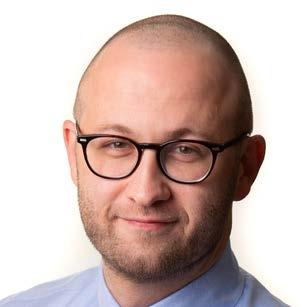
ExitIssues EI Tissue World Magazine | January/February 2023 40 ExitIssues EI
EI
Jacob Shapiro Director of Geopolitical Analysis Cognitive Investments
inping has big dreams for the rejuvenation of the Chinese nation and many of the Chinese Communist Party’s big goals were for 202 , but I think Beijing may admit to itself it has to push those back and strive for a little more accommodation in the short-term. Make no mistake, the long-term is still negative, but because of China’s weaknesses, I could see it making concessions to relieve pressure on its economy.
I am keeping a very close eye on Turkish politics this year. The country is moving into a decisive election over the summer. I’m less interested in the result and more interested to see if Turkey can reach a democratic decision that the entire country supports, and which does not lead to internal confict or strife. If it does, I will be feeling even more confdent in my bullish position on Turkey going forward. There are some very interesting developments to track in pariah states like Iran, Venezuela, and even Cuba. Iran is facing some of the most serious
China
anti-government protests in decades. Could we see a change in government in Iran that leads to a more accommodating political environment and more market access for Western companies? It is a longshot, but the upside would be tremendous.
In Latin America, the USA is showing signs it will reconsider some of its ideologically driven bilateral relations. They are just early signs, but a true softening between the USA and Venezuela and/or Cuba would be massive from a geopolitical perspective.
I am very bullish about Brazil and I think the concern about Lula as President is misplaced. He faces signifcant opposition at the domestic level – this is not 200 all over again, and the Brazilian economy is showing a lot of positive signals.
Demographic growth will be concentrated in sub-Saharan Africa, and perhaps to a lesser extent the Middle East and Southeast Asia. However, I do not expect that is where we will see the biggest increases in GDP per capita.
Retail tissue demand is projected to sustain growth momentum similar to pre-pandemic with and CAGR growth 2022202 in real value ( SD, fxed change, without infation) and volume, while nominal value sales are projected to grow at about CAGR for the same period.
Paper towel is expected to be the top performer in volume and value throughout forecast period, beneftting from increased home cooking, heightened hygiene routine and expanded demand for convenient multi-purpose cleaning agent.
Retail tissue is expected to grow roughly and in nominal value ( SD, fxed exchange) in 202 and 202 year-overyear, while increasing nearly and in real value ( SD, fxed exchange, without infation) and volume, respectively, for both years.
USA
Retail tissue demand is projected to further normalise from peak of pandemic demand and eventually resume marginal year-overyear growth pattern over the 2022-202 forecast period, with volume and real value sales contracting at a marginal fve-year CAGR (-0. and -0. , respectively) while nominal value sales growing at about 2 CAGR.
Nonetheless, overall and per capita retail tissue volume consumption is expected to stay above pre-pandemic levels throughout the forecast period, mainly supported by strengthening population and disposable income, heightened hygiene awareness as well as fexible work.
Toilet paper is expected to be the top performer in volume and value throughout forecast period, beneftting from enduring hybrid and remote working practice and subsequent increased at-home needs.
Retail tissue is expected to grow roughly 2 in nominal value (fxed exchange) in 202 and 202 year-over-year, but decline
In a multipolar geopolitical world, the countries that are best suited to success are either so small as to be non-threatening and to function as fnancial centres gateways to rival blocs, or are large enough to ensure economy of scale and market access for its countries. Examples of countries that ft the bill of this profle are Brazil, Turkey, Mexico, South Africa, and India. Each of these come with downside risks of course, but they each have the demographics, the manufacturing capacity, and the access to resources to succeed in a more geopolitically competitive world.
Depending on how the Russia-Ukraine war goes, Eastern Europe and Central Asia could either be phenomenal opportunities or absolute stay-aways. I am increasingly optimistic about Eastern Europe – someone will have to rebuild kraine, after all – and more cautious on Central Asia, but it is hard to make a defnitive call there while the war continues.
nearly in 202 and more marginally in 202 in both real value (fxed exchange, without infation) and volume for respective years.
Brazil
• Retail tissue demand has picked back up growth momentum in 2022 from a destocking-led contraction a year ago. Moving forward, it is projected to track about and 2 CAGR growth 2022-202 in real value ( SD, fxed change, without infation) and volume, while nominal value sales growing at about CAGR for the same period.
Paper towel is expected to be the top performer in volume and value throughout forecast period, beneftting from heightened health and hygiene awareness.
Retail tissue is expected to grow roughly and in nominal value ( SD, fxed exchange) in 202 and 202 year-overyear, while increasing nearly and 2 in real value ( SD, fxed exchange, without infation) and volume, respectively, for both years.
Turkey
Retail tissue demand is projected to grow at about CAGR growth 2022-202 in real value ( SD, fxed change, without infation) and volume, while nominal value sales growing at about 2 CAGR for the same period, refecting outsized infation efect. Paper towel is expected to be the top performer in volume and value throughout forecast period, beneftting from its versatile cleaning capacity.
Retail tissue is expected to grow roughly and 2 in nominal value ( SD, fxed exchange) in 202 and 202 year-over-year, given elevated infation. Besides, it is projected to grow about 2 and in both real value ( SD, fxed exchange, without infation) and volume for respective years.
Tissue World Magazine | January/February 2023 41 ExitIssues EI
Liying Qian, Head of Tissue and Hygiene, Euromonitor International, reports on growth in the global tissue market for TWM.

Advertiser Index & Subscription Tissue World Magazine | January/February 2023 42 ADVERTISER'S INDEX SUBSCRIPTION Tissue World Magazine is free to qualifed members of the tissue industry. Please visit the following link to subscribe to the printed magazines: www.tissueworldmagazine.com/print-subscription/ Sign up to the bi-monthly Tissue World Newsletter and six annual Digital Magazines herewww.tissueworldmagazine.com/newsletter/ Baosuo www.baosuo.com IBC Convermat www.convermat.com IFC Gambini www.gambinispa.com 2 Körber Fold www.koerber-tissue.com 13 Körber Tissue www.koerber-tissue.com 27 Tissue World Düsseldorf www.tissueworld.com 19 Tissue World Magazine www.tissueworldmagazine.com OBC Toscotec www.toscotec.com 37 Trebor www.trebor.com 8

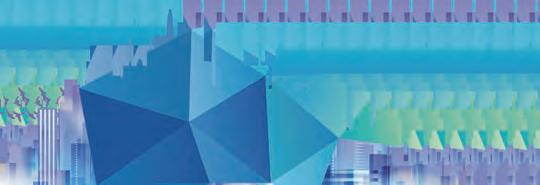



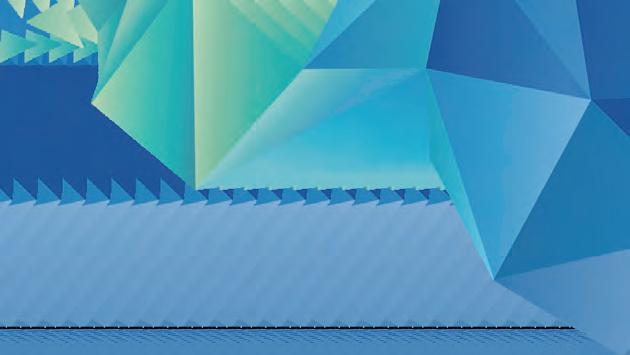

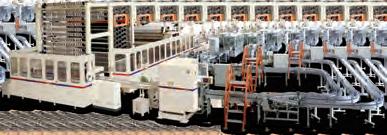

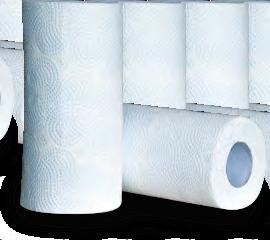

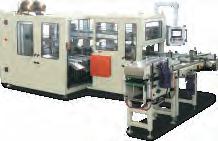


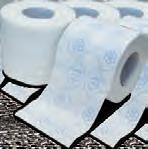
From print through digital, with webinars, whitepapers and more, download the media pack here:
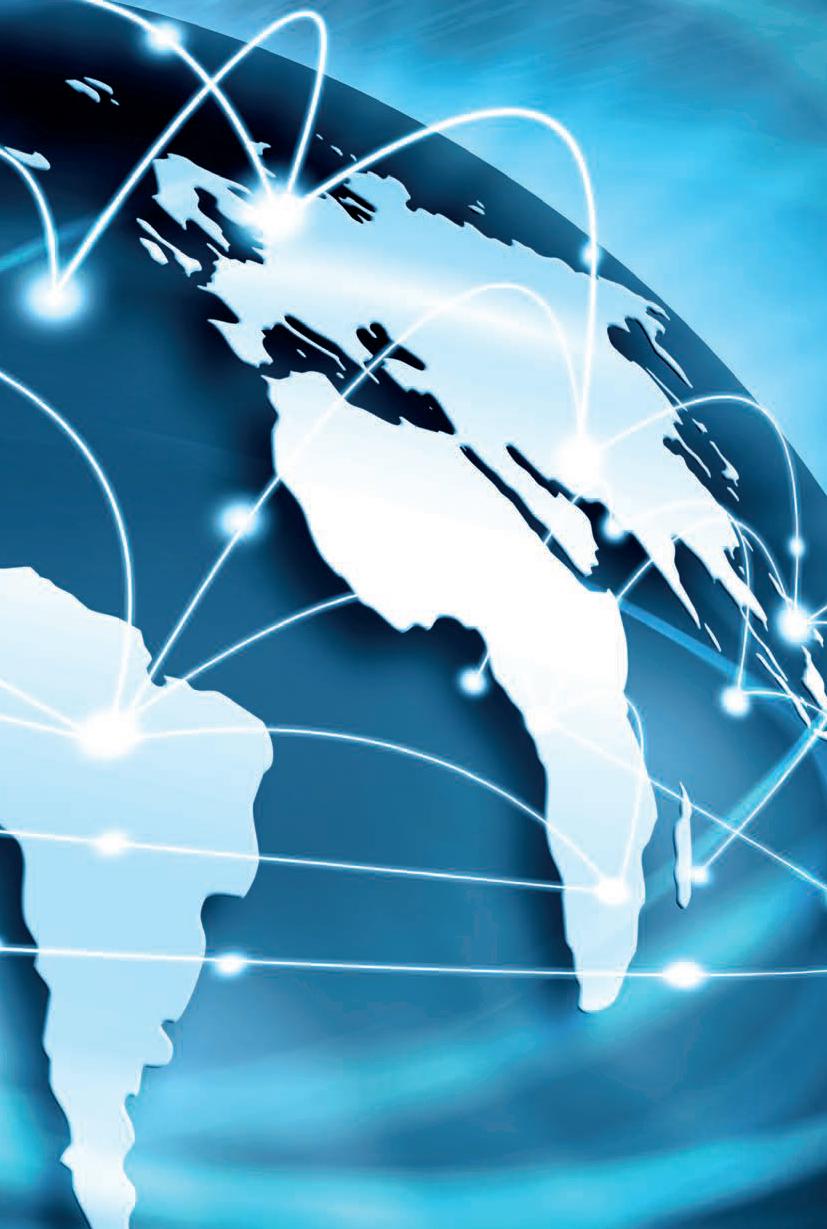
BUSINESS € The independent news provider for the global tissue business Plus … MarketIssues Costs reached record highs … how to mitigate the worst efects Project Survey 2022 Companies across the globe reveal record investments Technical Theme: Paper Machine Digitalisation evolving day-by-day towards more autonomous mills Tissue World Miami: Show Issue Tissue World Miami SHOW ISSUE January/February 2022 Issue #1 COUNTRY REPORT: MATURE MARKET’S UNPRECEDENTED RETAIL VOLUMES ITALY: THE 2022 BOUNCE Special Report: China How tissue performed in 2021 and development targets for 2022 ConsumerSpeak “Covid didn’t change my buying habits … but just wait till baby arrives” Tissue World Magazine is the leading, independent publication and online resource for the global tissue industry. We’re dedicated to publishing essential information, analysis, and opinion on breaking trends in business, technology, regional developments and sustainability, to keep tissue professionals up to date. Connect with your community,
your brand
the
THE INDEPENDENT NEWS PROVIDER FOR THE GLOBAL TISSUE
differentiate
and grow your business globally with
leading publication for your industry!
Get in touch today to discuss the opportunities and solutions: info@tissueworld.com Join the conversation:
































































































